|
Sant'Agostino
Prato di Sant'Agostino |
|
History
Augustinian, built from 1258,
with work still progressing in 1309.
The mendicant order of Augustinian Hermits relatively late foundation and need for large space for congregations,
they being a preaching order, means that their churches are usually found near,
or just outside, the city walls. A sepultuario of 1382 describes
the church as then divided by a screen into and upper church and a church
for women. The chapel in the right transept was added
during late-15th-century enlargement in 1487 and recently restored.
Internal renovation by Luigi Vanvitelli in 1755, following a fire in 1747, and an
entrance doorway designed by Agostino Fantastici in 1819. The church is now used for
cultural events.
Interior
A large neoclassical and aisleless space, remodelled in 1749 by Gaspare Vanvitelli, with two pairs of
marble 16th/17th century altars either side retained. They flank the
side door on one side and the door leading to the Capella Piccolomini on
the other.
One has a 1420 altarpiece with a sculpted Virgin
and Child, carved by Giovanni di Turino or Francesco di Valambrino,
but certainly polychromed by Taddeo di Bartolo and Gregorio di Cecco.
The high altar has the shrine of the Blessed Agostino Novello,
a local almost-saint who organised and worked to benefit the poor and
infirm from the hermitage of San Leonardo.
There are some very ordinary 17th-century
altarpieces, but also a Crucifixion (completed in 1506) by Perugino over the second
altar on the right, the Chigi, which shows the crucified Christ with the Marys and Saints
Monica, Jerome, John the Baptist and Augustine, all looking pretty languid
and relaxed. By the side door is
the altar of San Silvestro, which has a Baptism of Constantine
(1586/7) by Francesco Vanni which is impressive, if somewhat
frantic. The bearded figure staring out, to the right of Pope Sylvester,
is said to be a self-portrait of the artist.
The Capella Piccolomini in the quite
large former chapter house of the convent, which was converted into a
chapel in 1597 by Archbishop Ascanio Piccolomini, which is when the
frescos by Ambrogio Lorenzetti mentioned below would have been whitewashed
over. There is a crowded Adoration of the Magi
from 1530 by Sodoma over the altar. The youth in profile to the left of
Virgin is said to be a self-portrait.
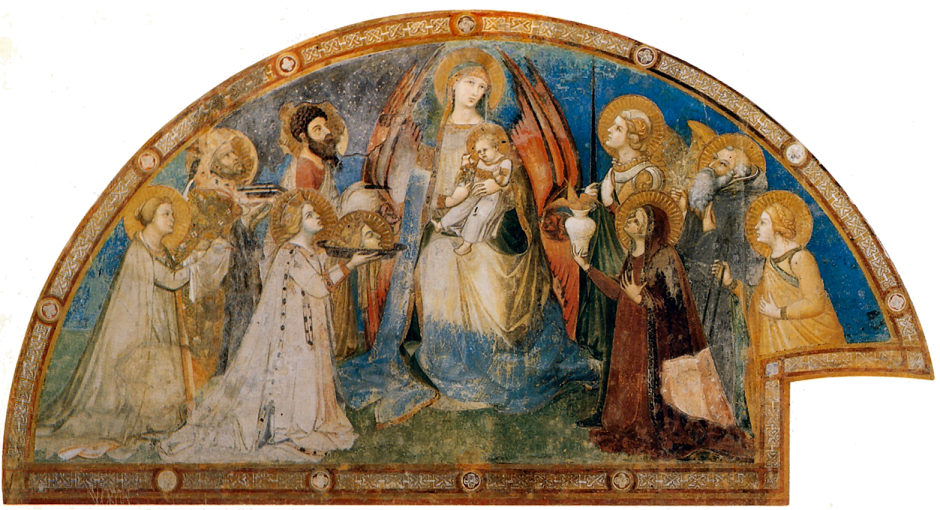
The church-highlight lunette fresco opposite is a Maestà by Ambrogio
Lorenzetti (see above) which was discovered during work in 1943
when the Sodoma altarpiece was being moved for safety from bombing.
Following the discovery the altar was repositioned into the opposite wall.
The lunette fresco is all that remains
of a seemingly-special cycle by Ambrogio, much admired by Ghiberti, devoted to the life of Saint Catherine of Alexandria.
Long after the whitewashing mentioned above renovation in the 18th century
largely destroyed the the frescoed walls. There have been many theories expounded to
explain its odd selection of sometimes hard-to-identify saints. A recent,
and quite convincing one, relates the painting to disputes amongst
Augustinians at the time of its painting. A meeting of the Order's Chapter
was convened in this very chapel in 1338. It does contain arguably the
most shocked-looking Baby in trecento art, as various female saints
present him with the bodily parts removed during their martyrdoms. Recent
restoration has identified a layer underneath thought to be an earlier
fresco by earlier (pre-Duccio period) Sienese hands.
The second (Bichi) chapel to
the right of high altar has
two lunette medallions of the Tiburtine and Erythraean sibyls by Luca Signorelli and monochrome frescoes of the
Birth of the Virgin and the Nativity by
the multi-talented Francesco di Giorgio and collaborators, including Pietro di
Francesco Orioli, painted c.1488/91, and found under whitewash during
restoration work in the 1970s. Preparatory sketches are in Hamburg. The
chapel was founded by noblewoman Eustochia Bicchi in memory of her
husband. When her father Antonio Bichi returned from exile to lead a new
government he took over the commission. Francesco and Signorelli's altarpiece is
long gone, see
Lost art
below.
The sacristy chapel has fragments of frescoes of the Infancy of
Christ with Saints by Paolo di Giovanni Fei from c.1373/75, his earliest
known work.
Jacopo della Quercia is said to have been buried here.
Lost art
The fine Blessed Agostino Novello
and Four of his Miracles (c.1330) by Simone Martini (see right) is now in the
Pinacoteca and is one of only three works by him remaining in Siena. It
was painted to be placed on the subject's tomb here, hence the unusual
polygonal top. The four flanking scenes showing Agostino's healing
miracles, with him swooping in to save the victims of accidents, mostly
children, are probably the work of assistants. The painting was part of
the movement to get the Blessed Agostino canonised, but it didn't happen,
making Martini's haloes look more than a little presumptuous.
Seven panels of Scenes from the Legend of Saint Stephen from c.1390
by Martino di Bartolomeo are in the Städel in Frankfurt. They are probably
from an altarpiece installed here, but are missing their central panel
depicting the standing saint. Scenes depicted include the baby Stephen
being exchanged by a devil with a changeling and the return of Stephen
with the subsequent burning of the changeling on a pyre.
The Bichi altarpiece from the late 1480s/early 1490s, painted to go in the family chapel
mentioned above, by Luca Signorelli and Francesco di Giorgio was disassembled and dispersed
c.1755, and some elements are now lost. It was commissioned in memory of Cristoforo
Bellandi, the deceased son-in-law of Antonio Bichi. The central
polychromed wooden
statue of Saint Christopher is by Francesco di Giorgio and is now in the
Louvre. It stood in a tall recessed niche with painted nude figures
dressing and undressing beside a river. Signorelli's large flanking panels depicting Saints Jerome, Catherine
of Siena and Mary Magdalene on one side, and Saints Francis,
Augustine and Catherine of Alexandria on the other, are now in Toledo
and Berlin, with predella panels in the Dublin National Gallery (The
Feast in the House of Simon), Pollok House in Glasgow (Lamentation
over the Dead Christ) and the Clark Institute in Williamstown,
Massachusetts (The Martyrdom of St Catherine).
Once in the Capella Piccolomini here is one of the
three odd
and harrowing versions of the Massacre of the
Innocents by Matteo di Giovanni from 1482 - it is now in the Capella della
Madonna in the Santa Maria della Scala Ospedale. It was probably
commissioned for this church because it had a relic of a foot of one on the
Innocents. Fragments of its
lunette, of the Virgin and Child flanked by Angels, are in the Keresztény
Museum in Esztergom and a private collection. Matteo's previous
Massacre was painted for Santa Caterina a Formello in Naples in 1468,
and the later one was painted for
Santa Maria dei Servi in 1491. He came
from Borgo Sansepulcro and was probably trained by Vecchietta.
Opening times
mid-March to end Oct 11.00-1.30 & 2.00-5.30
These are the times publicised, but I never found the church open on
a visit in 2016 and only finally got in during the big Ambrogio Lorenzetti
exhibition of 2017/18 when the church was specially opened. The attendant said that when the exhibition finished access would return to being
very rare. It was indeed never open when I (frequently) walked past in April
2019.
|
|
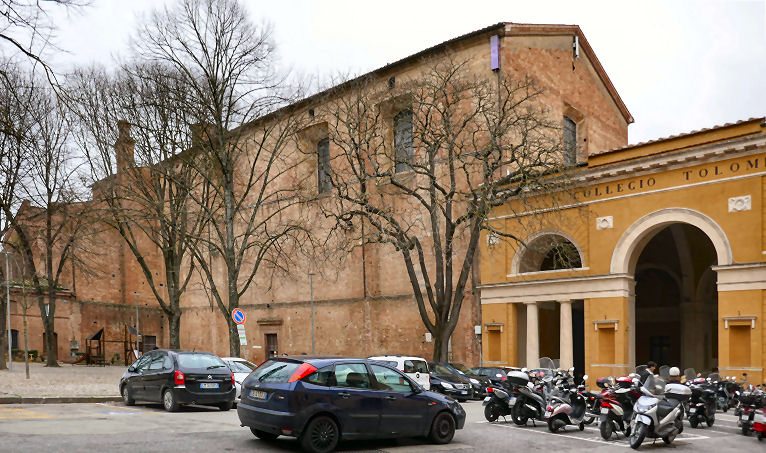
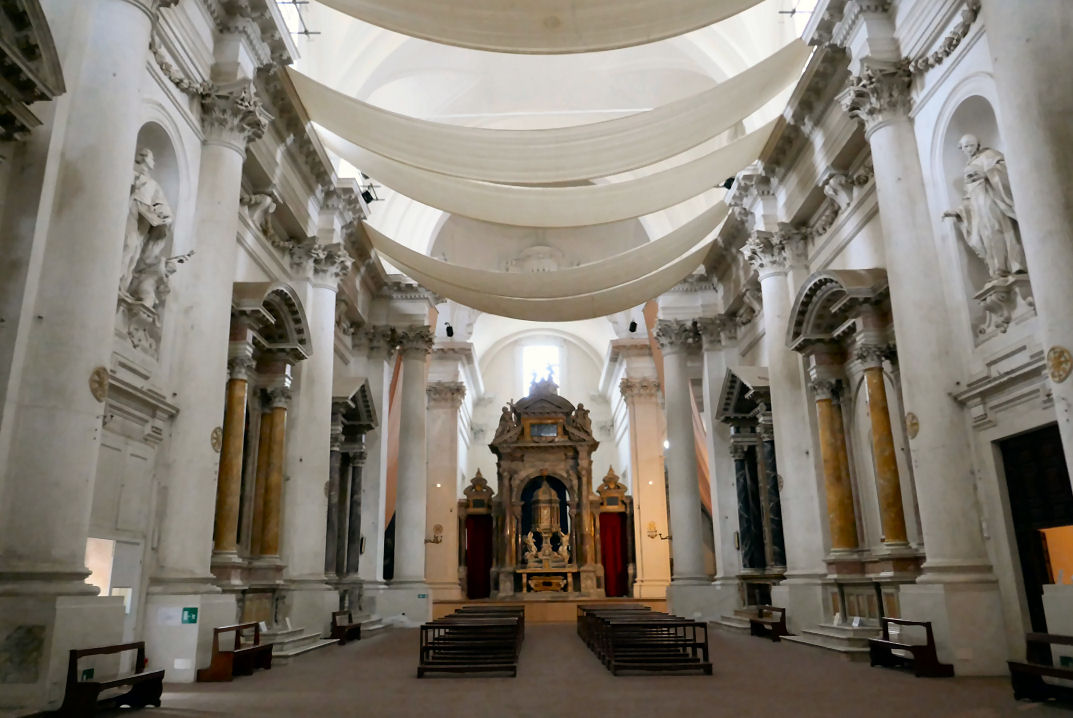
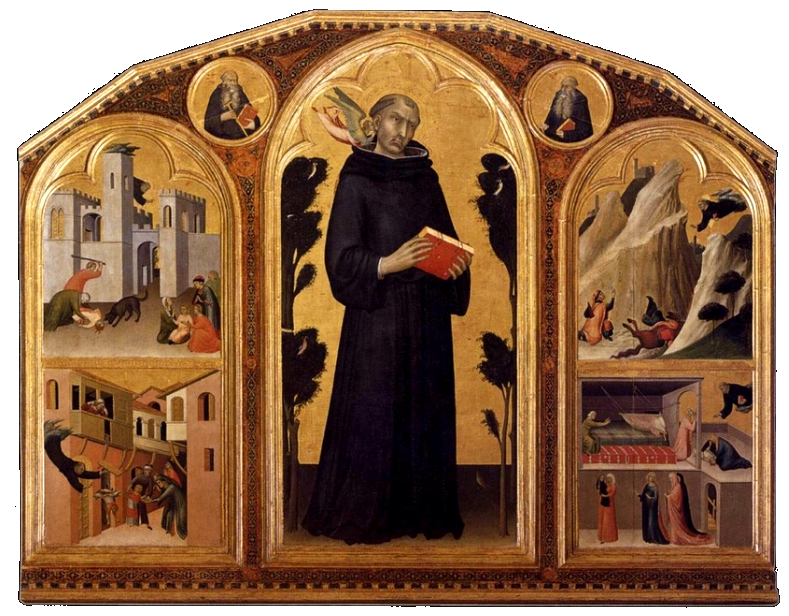
 |
|
Sant’Andrea Apostolo
Via dei Montanini |
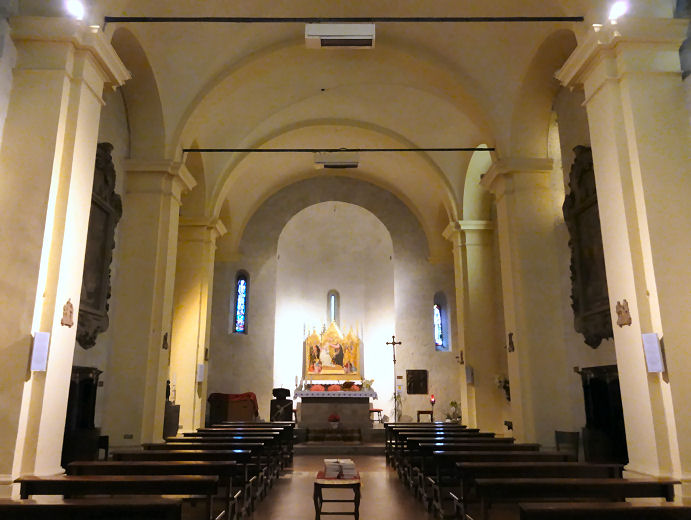 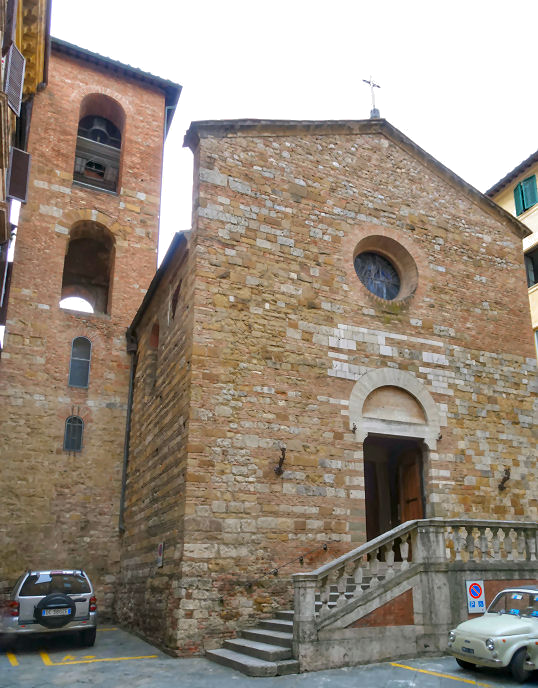
History
Romanesque, founded in 1175, with major 18th century adjustments
Interior
Small and aisleless with a nice mix of rough brick walls and smooth pilasters
and arches creating five shallow bays each side of the nave. A plain stone
walled apse with a shallow altar bay each side,
with frescoes. Modern stained glass in the thin clerestory windows.
On the right a Saint Anne with the
Virgin and Child
fresco, possibly by Martino di Bartolomeo, from the early 15th
century and discovered during restoration in 1959.
Opposite, in the second bay on the left, there are more damaged fresco remains of
a representation of the architectural ornament of an altarpiece, very
redolent of Simone Martini's Maesta in the Palazzo Pubblico, with Jesus and Seraphs in the
lunette and San Bernardino on the right niche wall. They date to
around 1370, the label
in the church describing them as Sassettiana. There are a couple of fragments on
the wall above too.
The Glory
of Saint Andrew by Giuseppe Nicola Nasini is to the right in
the last bay on the right, and there's a fresco panel
of Beata Aldobrandesca Ponsi by Apollonio Nasini (his son) in the third on the
right. Also by the latter is a matching fresco opposite of Sant'Alberto da
Chiatina 1756.
Over the high altar is the splendid Coronation of the Virgin with Saints Peter and
Andrew (1445) signed by Giovanni di Paolo, a unified-field polyptych
Opening times
9.00 - 7.30
|
|
Sant'Ansano
(Cappella delle Carceri di...)
Via San Quirico |
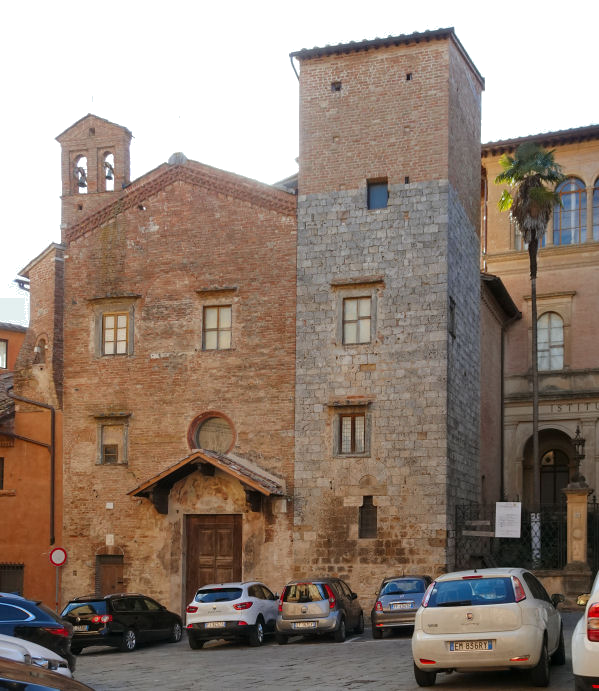

History
One of Siena's patron saints. He's a
3rd-century saint, so the legend that he was imprisoned in the tower to the
right of this 16th-century church, admittedly built on the site of an
older church, is hard to accept.
Interior
unvisited
The saint is depicted in the stained
glass window in the oculus above the door, the high altarpiece of 1617 by Rustichino and in the fresco fragments on the left wall attributed to
Priamo della Quercia, the brother of sculptor Jacopo.
Lost art
The famed Annunciation with Saints
Ansanus and
Massimo of 1333 by Simone Martini and Lippo Memmi, his
brother-in-law, painted for the altar of Saint Ansanus in the Duomo, was
moved here towards the end of the 16th century when that altar was
remodelled. It remained here until went to the Uffizi in 1799.
Opening times
Rarely
Interior photo from the (now defunct)
My Day Worth blog |
|
Sant'Elisabetta della Visitazione
Via dei Rossi |
|
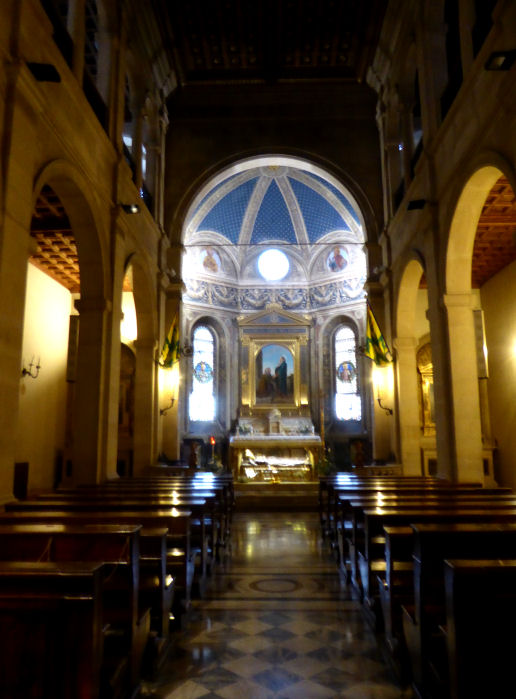 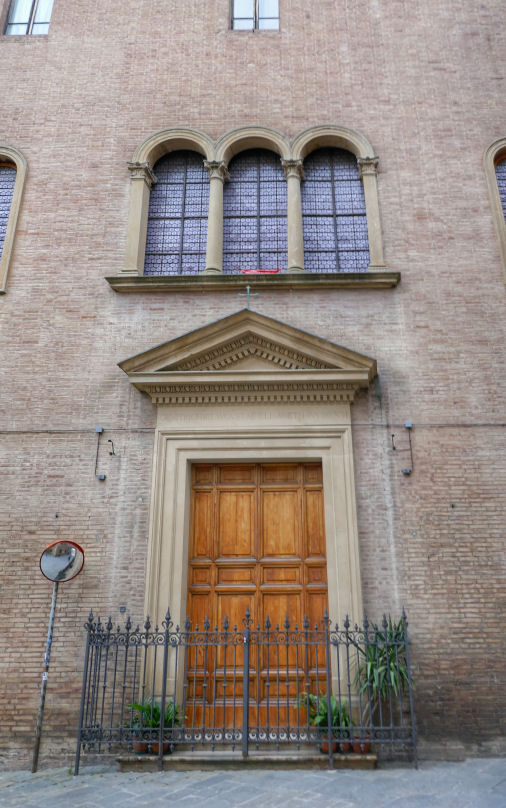
History
The original church dates to 1680, but the current church was built in the
late 19th century by the Blessed Savina Petrilli for the Order of the
Sisters of the Poor of Saint Catherine of Siena, which she founded in 1873.
Building began in 1884 to neo-renaissance designs by Agenore Socini and was
completed in 1901.
Interior
Nave and aisles separated by wide pillared arches supporting a high
gallery. Aisle walls utterly plain with altars at the aisle ends flanking
a shallow
five-sided decorated apse. Modern panels.
The decoration was overseen by
Alessandro Franchi, responsible for Saint Joseph on the back wall
of the left aisle, the Visitation in the apse and the Stigmata
of Saint Catherine of Siena on the back wall of the right aisle,
the latter carried out in collaboration with his wife Luisa Mussini (the
daughter of painter Luigi Mussini, who was Franchi's tutor) she being also
responsible for the Saint Anthony of Padua in the chapel named for
him.
On the altar a Virgin and Child by Luca di Tommè.
Under the altar are the remains of Savina Petrilli
(1851-1923)
she being one of the 31 “saints, beatified, and servants of God”
controversially mummified between 1975 and 2008. Controversial also for the
fact that of the team of the embalmers only one was still alive
in 2014 when the issue
was reported, the others having died of various tumours and cancers,
likely side effects of the toxic chemicals used in their work.
|
Sant'Antonio da Padova(1)
Sant'Antonio alle Murella
Oratory -
Via Tommaso Pendola |
|
Sant'Antonio da Padova(2)
Oratory
-
Via Cecco Angiolieri |
|
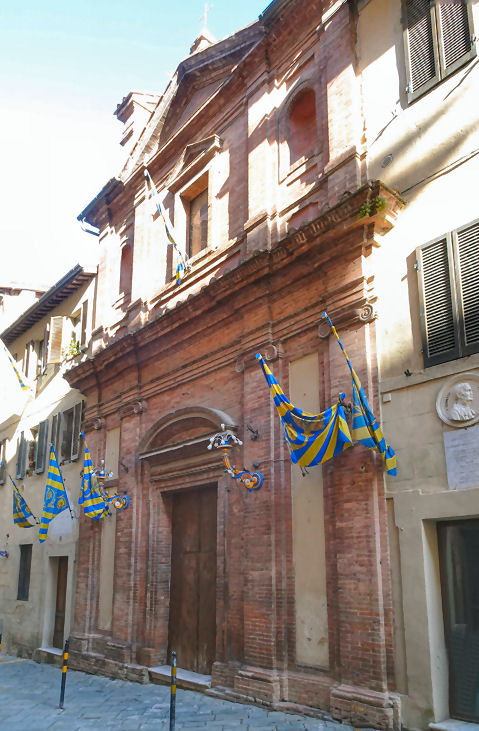
History
In the late 17th century locals from
the Contrada della Tartuca (Turtle),
many of them sculptors and masons, acquired property from the Augustinians.
Construction of an oratory began in 1682, to a Baroque design by Jacomo Franchini.
with the church completed in 1685.
Interior
unvisited
Much work by the Mazzuoli
family, and some by the Nasini. Giovanni Antonio Mazzuoli was responsible
for the interior sculptural decoration and
the main altar with its bas-relief of the Apparition of the Virgin to Saint Anthony
of Padua.
The high altarpiece depicts The Miracle of Saint Anthony
Restoring an Amputated Leg. The same miracle
is depicted in inlaid marble mosaic in the floor by Leopoldo Maccari from 1891.
The cupola
has frescoes depicting Saint Anthony in Glory by Vincenzo Dei. The
side altars, built in the late 1700s, are the work of local sculptor Gaspero
Fineschi and stucco artist Bernardino Cremoni.
Four oval paintings of 1685-6 - The Saint Jerome and the Angel
is attributed to Giuseppe Nicola Nasini, the Martyrdom of St
Bartholomew is by Antonio Nasini (Giuseppe's brother), Saint Sebastian healed by Saint Irene
and
St Ansano Baptizes the First Christians of Siena are by Annibale
Mazzuoli.
Saint Anthony Preaches to Fishes (1697) by Annibale Mazzuoli; a stucco bas-relief of
The Virgin offers her Baby Jesus to St Antonio, by Giovanni Antonio Mazzuoli (1685); a wooden altarpiece
with Scenes in the Life of Saint Anthony by Antonio Manetti and Angelo
Barbetti (1831-1832); a Virgin and Child, by Francesco Mazzuoli (1836).
Campanile
Rebuilt in 1800.
Opening times Rarely
|
|
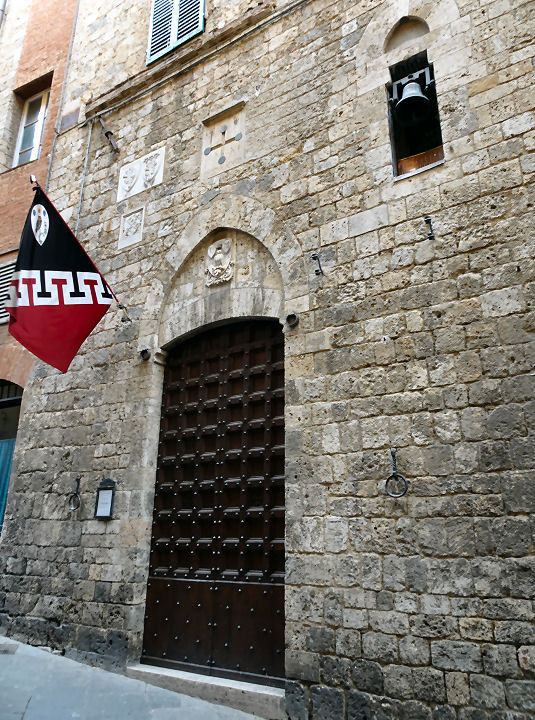
History
The Contrada Priora della Civetta
(owl) was the last contrada to build its own oratory, they having
previously used an altar in the church of San Cristoforo, just up
the street. Built on the site of a shop shop, on the ground floor of a
medieval palace, which was bought by the Contrada in 1932. By 1934 the
façade and entrance were finished, and in 1936 the marble altar. Financial
problems and the war prevented completion, until the Oratory was finally
opened for worship in 1945. Major rebuilding in 1973 when the interior
plasterwork was removed, painted in white and dark horizontal stripes in a
Sienese style, returning the walls to brick and stone.
Interior
unvisited
An 18th-century painting of
Saint Antony of Padua by Galgano Perpignani, and a 17th-century
Virgin and Child, San Giovannino and
San Carlo Borromeo with San Luigi Gonzaga
by Vincenzo Rustici, given to the Contrada by
Count Guido Chigi Saracini.
Opening times Rarely |
|
Santa Caterina
Casa e Santuario
Costa di Sant'Antonio |
History
Four churches on three levels on the site of the family home of Caterina
Benincasa, who was the youngest of the twenty-four children of a leather
and wool dyer. Born in 1347, she had of vision of Christ dressed as the
pope with Saints Peter, Paul and John in the sky over the church of San
Domenico at the age of 6. She joined the Dominican Mantellate (order of
laywomen) and later acquired the stigmata from a Crucifix in Pisa
(on April 1st), the marks only being visible to herself. She also successfully badgered Pope Gregory XI
by letter to bring the papacy back from Avignon. She was canonised by the Sienese Pope
Pius II on the 1st of July 1461, was later made the
joint patron saint of Italy in 1939, and later still of Europe.
This house, where she was born, probably, became a sanctuary devoted to her
memory after being bought by the comune in 1466. The surrounding
area was one of Siena's poorest, being the heart of the leather-tanning
and wool industries and the site of the city's abattoir.
Interior
Entrance is through a loggia of 1941, the Portico dei Comuni
d'Italia (see right), the building of which involved the demolition
of the ancient parish church of Sant'Antonio, down
some stairs into a smaller loggia of 1533,
possibly by Peruzzi or Giovanni Battista Pelori, a follower.
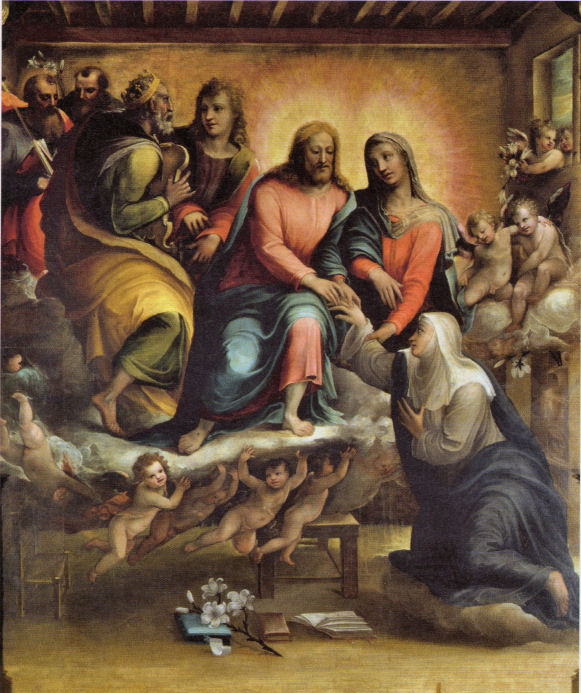
To the left here is the
Oratorio della Cucina which was the
family kitchen converted into an oratory in the 5th and 16th centuries,
with a flat coffered ceiling by Bastiano di Girolamo completed in the late
16th century (see below right). The art is from the same century and mostly subtly mannerist. Over
the entrance is Christ Changing the Heart of Saint Catherine of Siena by
Francesco Vanni from c.1590. The altarpiece is by Bernardino Fungai. The
wooden stalls around the wall date from 1518 and 1555 and the lovely
polychrome majolica tile pavement is from the same century. The panel of
The Mystic Marriage of St Catherine of 1571 (see right) is by Bartolomeo Neroni
(Il Riccio), completed by Arcangelo Salimbeni in 1578. The saint's own
account recalls the mystic marriage of Saint Catherine of Alexandria,
after whom she was named, and tells us the ring was made of Jesus'
foreskin. The frantic
Conversion of those Condemned to Death of 1578/80 is by Lattanzio Bonastri,
who had studied in Rome with El Greco. Saint Catherine of Siena Curing a
Possessed Woman from 1587 is an early work by Pietro Sorri.
Opposite the oratory is the classical façade of the
Oratorio del Crocifisso. It's aisleless, baroque, or borderline rococo
inside (see further
below right), being built in 1623 to house the (late 12th century Pisan)
Crucifix in front of which Saint Catherine received the stigmata in
Pisa on the 1st of April 1375 in the church of Santa Cristina. It is kept over the high altar in a cupboard decorated by
il Riccio (Bartolome Neroni), with panels depicting Saint Catherine
(on the left) and Saint Jerome. Flanking it in the apse are scenes
from the life by Giuseppe Nicola Nasini.
In here are lots more 17th and 18th century paintings of Saint Catherine's
dealings with the Pope and sundry miracles and ecstasies. Over the right transept altar is
an altarpiece by Sebastiano Conca of Saint Catherine before Pope
Gregory XI and in the north
transept a very baroque The Virgin welcomes Saint Catherine
introducing her to Jesus of 1636 by Rutilio
Manetti and his son Domenico. The ceiling is all frescoed including, in the cross vault of
The Glorification of Saint Catherine 1701-3 by Giuseppe Nicola
Nasini.
Downstairs
is the Camera della Santa, the saint's
bedroom turned into an oratory after 1541. From 1550-1623 it housed the
Crucifix now upstairs in the Church of the Crocifissoo. The oratory was
frescoed in 1893-6 by Alessandro Franchi, from Prato, and Gaetano
Marinelli, from Siena, in a style that looks it.
Over the altar is a small painting from the early
16th century of Saint Catherine Receiving the Stigmata by Girolamo di Benvenuto. Through the
metal doors at the back can be seen the room called the cubiculum, where
various mystical experiences were said to have happened, with a cabinet of relics and a
modern sculpture by Pietro Reposo.

To the right outside the Camera are steep stairs down to the Oratorio
della Tintoria or Santa Caterina
in Fontebranda, (see left) built between 1464 and 1474 on the site of a
the saint's fathers's basement wool-dying workshop
(tintoria). The church's design is locally attributed to Francesco
di Giorgio. It is not part of the visit as it is now the contrada church.
There's a polychrome wooden statue of the saint by Neroccio di
Bartolomeo de' Landi from 1474, which may also have been carried in the
saint's feast day processions as it is also carved and painted on the
back. Frescoes of five angels by Sodoma and
scenes from the life by Girolamo del Pacchia, Vincenzo Tamagni,
Giacomo Pacchiarotti and Ventura Salimbeni.
Opening times 9.00 - 12.30 & 3.00 -
6.00 Contrada dell'Oca (goose)
|
|
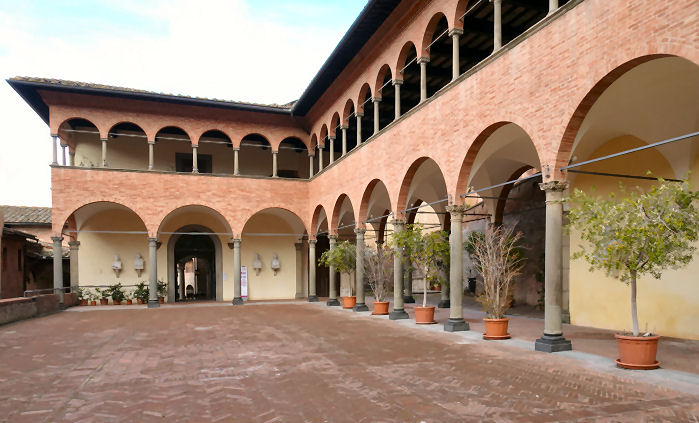
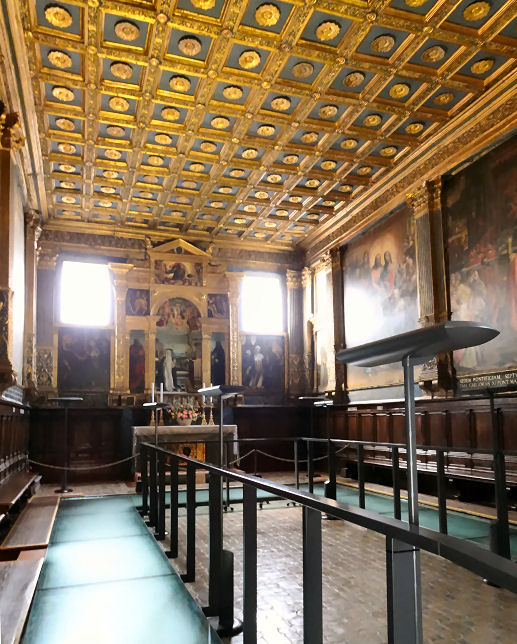
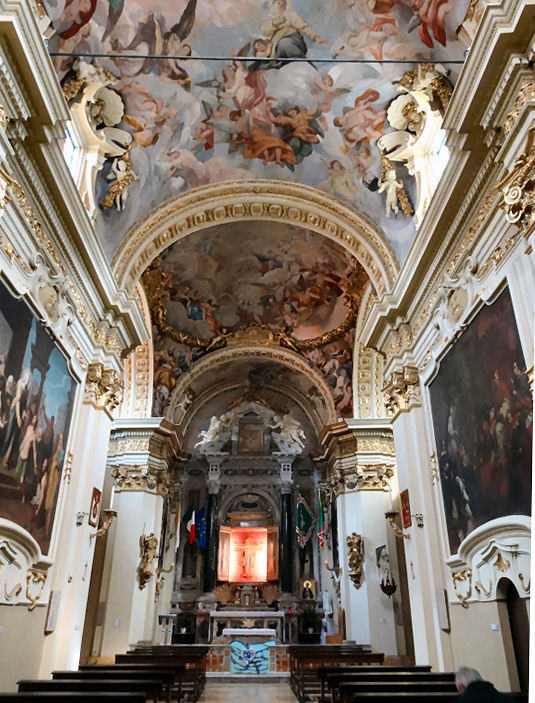
|
|
Santa Caterina del Paradiso
Oratory -
Piazza Giacomo Matteotti |
|
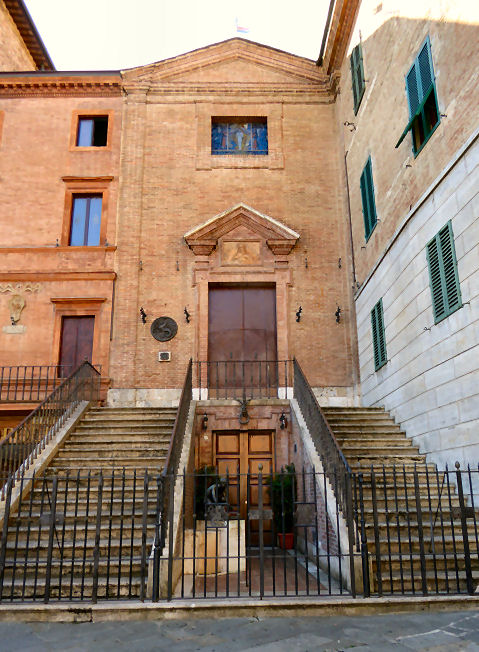
History
Dedicated to Saint Catherine of Siena this church was founded in 1479 long
being the church of the nuns of Santa Caterina del Paradiso, from which
the church got its name. This original church was rebuilt 1620-26 as we
see it today, with more work after a fire in 1693/4. In 1787 the
church became the oratory of the Contrada del Drago when it was given to
them by the Grand Duke of Tuscany, Pietro Leopoldo and now houses
the contrada's museum.
Interior not visited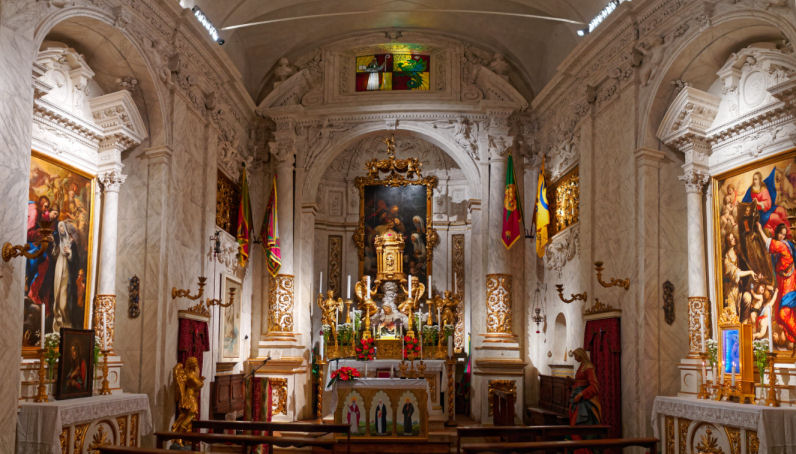
Baroque with a single nave, three
bays and a deep apse. On the marble high altar by the Mazzuoli workshop
(1694) there is a bust of Saint Catherine of Siena in polychrome
terracotta by Lorenzo di Mariano, known as Marrina of 1517 or 1521/24.
Behind is a Pietà with Saints by Vincenzo and Francesco Rustici
from 1613. Also here is the venerated Madonna della Tegola, painted
by an unknown artist of the 17th century on a tile, commemorating the
apparition of the Virgin to a nun. The image is evidently visibly inspired
by the Madonna della Quercia in Viterbo.
On the side altars to the right and left, the Virgin and Saints Mary
Magdalene and Catherine of Alexandria (three paintings?)
respectively with the image of Saint Dominic in Soriano by Domenico
Manetti (1648-9 ) and the Mystic Marriage of Saint Catherine of Siena
by Raffaello Vanni (1650).
On the right wall is a polychrome
terracotta Annunciation by Marrina which, like his bust of Saint
Catherine of Siena, dates back to the original church.
Local lad
Famed Sienese
picture restorer and forger J.F. Joni had his first solo studio next to this
church.
Opening times Rarely
|
|
Santa Lucia
Santi Niccolò e Lucia
Pian dei Mantellini |
|
History
The church of the lay confraternity of
Santi Niccolò e Lucia. Renovated in the 16th and 17th centuries
Interior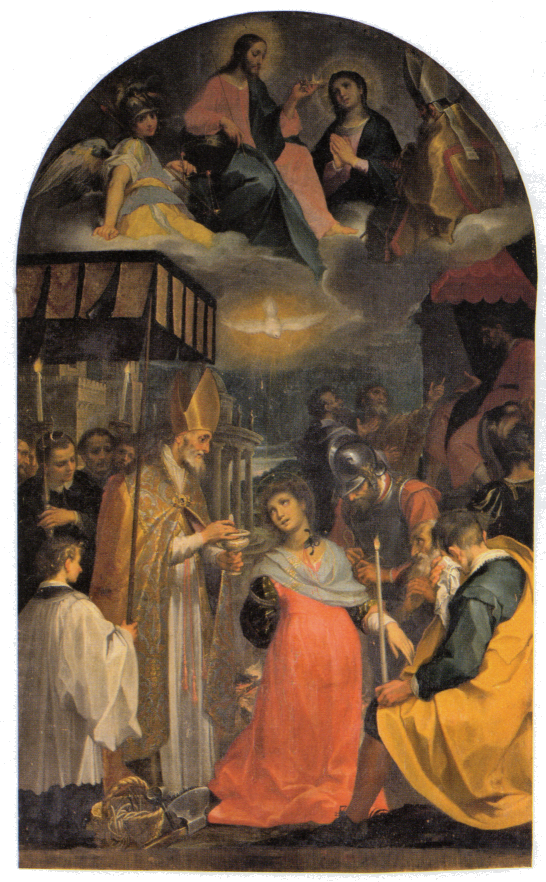
Small, pale baroque, white stucco
with dull gilding and aisleless with a pair of side altars. There's a
large barrel vaulted organ gallery over the entrance.
Over the left
side altar a
carved Crucifix with painted staffage. Over the right one 18th-century stucco angels and putti surround an
old icon-like painting of a crowned Virgin.
The barrel vaulted
ceiling and lunettes over side chapels are frescoed, with a trompe
l'oeil
balustraded dome in the
centre.
These 17th century vault frescoes are the work of Sebastiano Foli
and Francesco Bertini.
The shallow baroquely- gilded
rectangular apse has grills either side and a high altarpiece of the
Last Communion and
Martyrdom of Saint Lucy (see right) by Francesco Vanni of 1596-98. (Vanni
was an active member of the confraternity of Santi Niccolò e Lucia for
much of his life.) Flanking the
apse are 15th-century polychrome statues of Saint Lucy
attributed to Francesco di Giorgio Martini and Saint Nicholas by a
follower of Giovanni di Stefano.
Now
attached to the wall behind a glass panel to the left of the apse is a
small panel of Saint Nicholas of Bari Saves
Girolamo Biringucci From Torture by an unknown Sienese artist, from 1496,
action-packed and looking very much like a panel from a comic strip.
Opening times
8.00 - 1.00 & 2.00 - 6.00
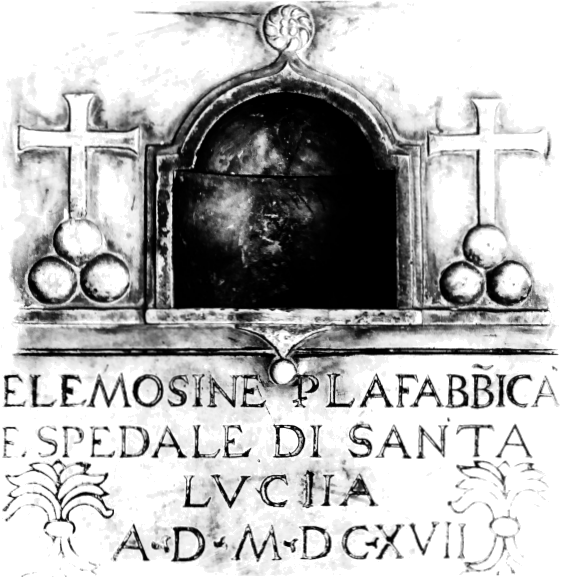 |
|
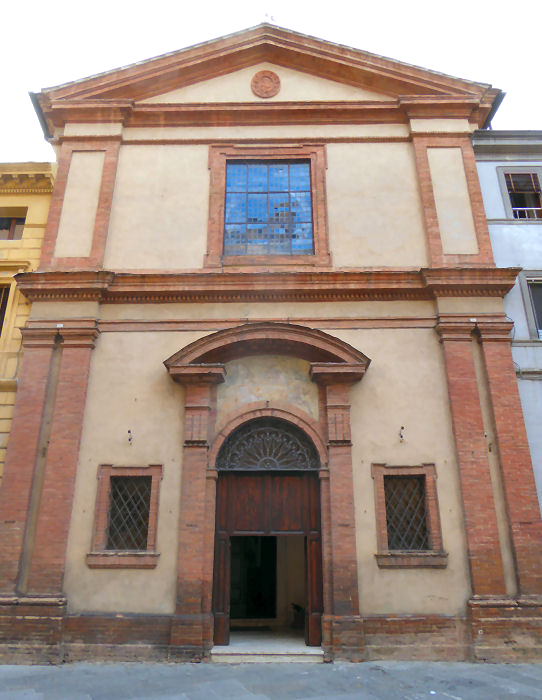
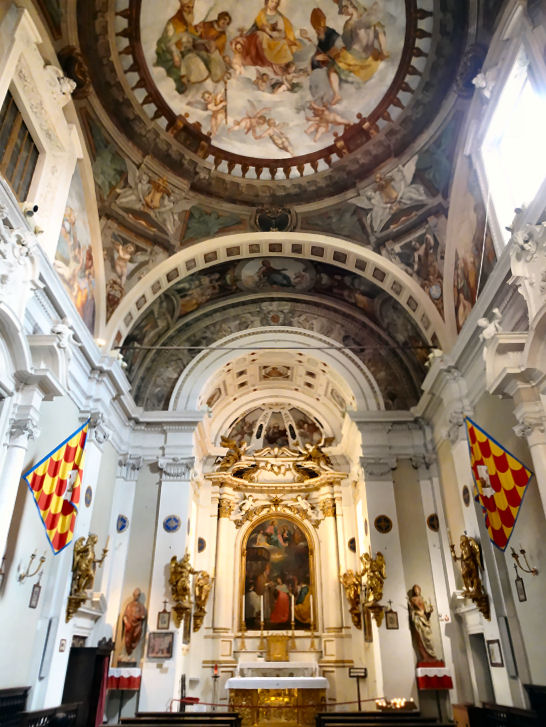
|
|
Santa Maria dei Servi |
|
Santa Maria della Scala
Ospedale |
this church now has its own page
|
|
this complex now has its own page
|
|
Santa Maria delle Nevi
Via Banchi di Sopra |
|
History
Built as a family chapel from 1470-1472 for Giovanni Cinughi,
the first Bishop of Pienza,
whose coat of arms can be seen on the façade, but who didn't live to see
the church completed. It was built possibly to a design by
Francesco di Giorgio, possibly carried out by his pupil Bastiano di Corso, a Sienese-born architect, painter, sculptor
and civil and military engineer. Or maybe Lorenzo di Pietro (Il
Vecchietta) a painter and sculptor and also a pupil of Francesco di
Giorgio. It was built as part of the convent of Sant'Egidio (the
Cappuccine Sisters), demolished by the first decade of the 20th century
for the construction of the Piazza Umberto I (previously called the Piazza
delle Cappuccine, now officially called Piazza Giacomo Matteotti, or
Piazza della Posta by locals) leaving only the church. The church has been 'temporarily' closed for restoration for many years,
but see below.
The
church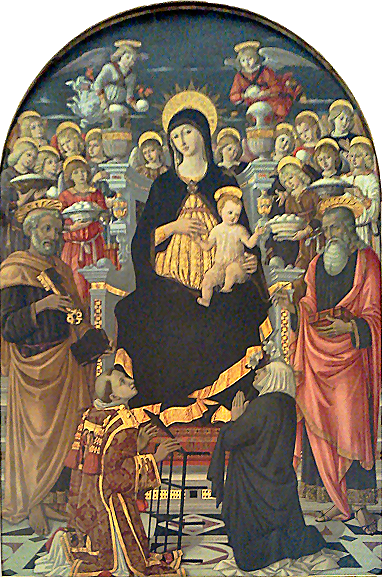
Free-standing with a very classical marble and pietra serena
façade, featuring an all'antica freeze and the Cinughi coat of
arms.
Interior
Very bare and
tall,
with whitewashed walls and ceiling divided into two
cross-vaulted
squares. Two plain windows high on left wall, with two
matching
painted ones on
the
wall opposite.
The
high
altar
is
flanked by plaster
portrait
ovals.
The Madonna della Neve high altarpiece by Matteo di
Giovanni (usually now in the Pinacoteca)
was returned here for
special openings in 2019. Good to see in situ but a light would have been
nice.
Lost art
The high altarpiece was the Madonna della Neve,
signed and dated
1477 by Matteo di Giovanni (now in the Pinacoteca) (see right)
commissioned by the Cinughi heirs. It features cherubs making snowballs
and angels with bowls and amphorae of snow. It was
originally in the (now demolished) monastery of Sant'Egidio. The legend
of the origin of Santa Maria Maggiore in Rome is depicted in the predella
- a miraculous fall of snow which miraculously marked the outline of the church
to be built, on the night of the 4th/5th of August 352.
Opening times Rarely
Update Run by the Pinacoteca, there were
'extraordinary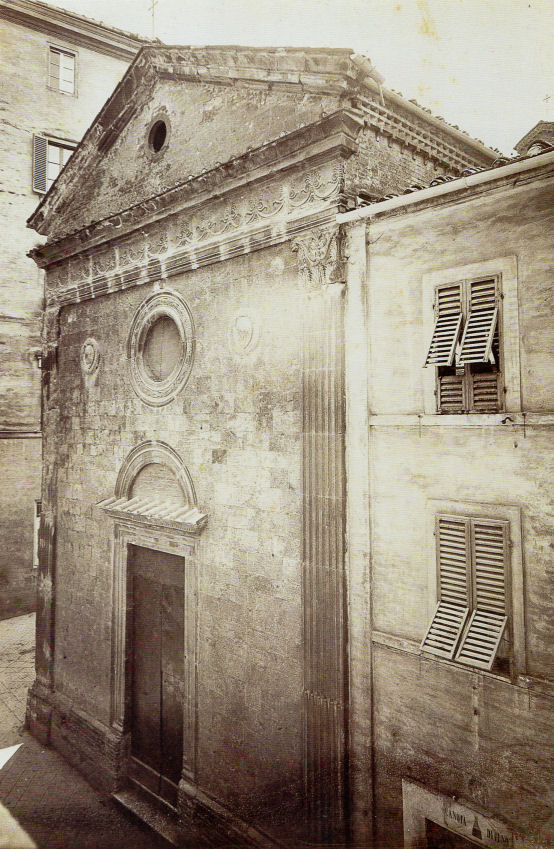 openings' in 2019, when I visited, but only one
such opening was announced for 2o21. Since then none have been announced.
openings' in 2019, when I visited, but only one
such opening was announced for 2o21. Since then none have been announced.
A photo taken around 1880
(Alinari)
|
|
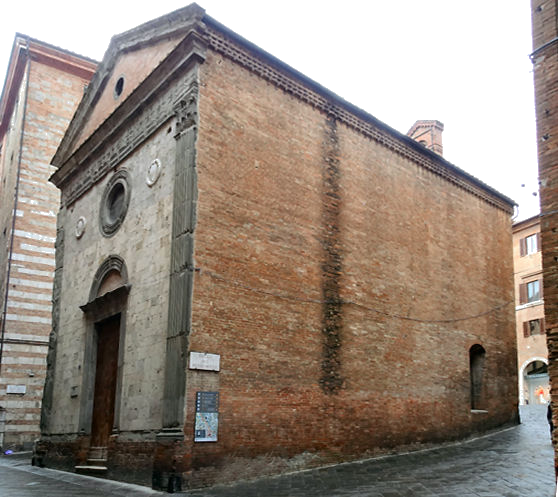
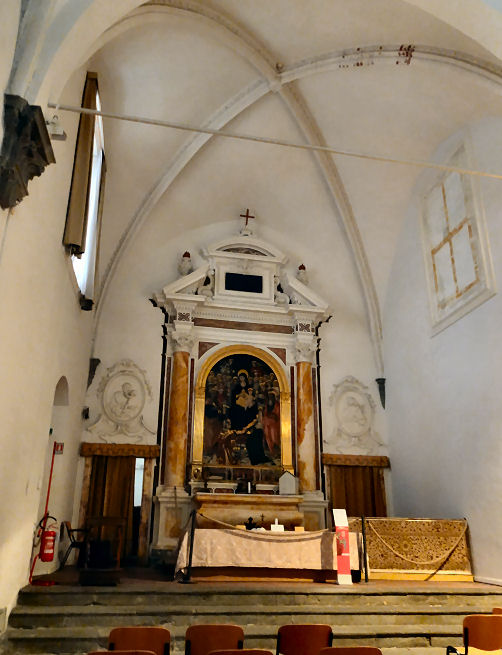
|
|
Santa Maria in Portico a
Fontegiusta
Via di Fontegiusta |
History
Built 1482/84 to Renaissance-style designs by Francesco di Cristoforo
Fedeli from Como to celebrate the victory of Siena over the Florentines
in the Battle of Poggio Imperiale fought in Poggibonsi on September 7,
1479.
The former Porta de Pescaja, also known as Porta Fontegiusta, was a city
gate, sited where the apse is now. It was walled up as Siena tried to
limit access to the city during times of conflict.
Façade
The facade remains brick. The doorway (1489) is the work of Urbano di Cortona,
with a bas-relief of the Virgin and Child with Angels above attributed to Giovanni di Stefano.
Interior
Almost square, as space was limited, what
with the church being built up against the city wall. A nave and two
aisles,
supported by two
columns each side, so with nine cross-ribbed square vaults.
On the left wall is a fresco of The Sibyl Announcing the Birth of Christ to the Emperor Augustus once attributed
to architect Baldassare Peruzzi (who lived nearby) but now thought to be
a work of Daniele da Volterra, or both of them.
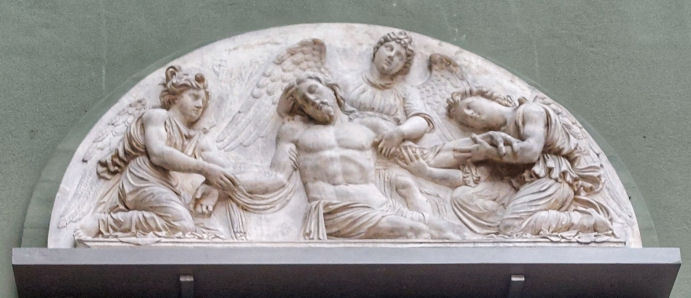
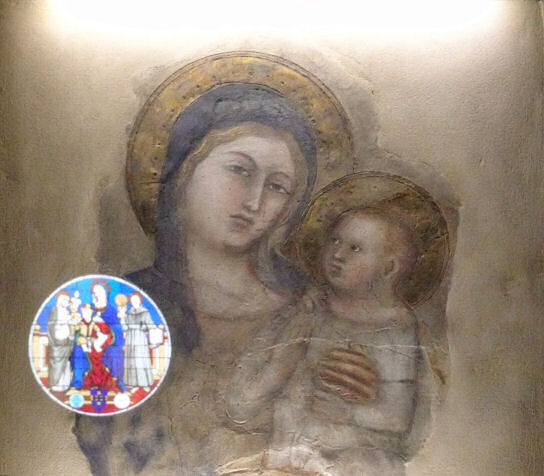
The marble high altarpiece, called the
Fontegiusta Altarpiece (1509-17 - the first is the date of the
contract the second the date on the inscribed on the ensemble) is attributed to
Lorenzo di Mariano, called il Marrina, who also carved the lunette of
The Dying Christ Held by Three Angels. (There's a monochrome cast of
this lunette in the cast court of the Victoria and Albert museum in London
(see above), it being considered Il Marrina's masterpiece.) In the tabernacle is the
miracle-working Madonna di Fontegiusta by Lippo Vanni (see
right) originally
part of a fresco from the portico of the customs house. The large lunette
fresco above of The Assumption (1515) is by Girolamo di Benvenuto, with
an Annunciation in the frieze
below and frescoes flanking the tabernacle depicting the Birth of the
Virgin and The Virgin in Glory /Death of the Virgin (1600) by Ventura
Salimbeni.
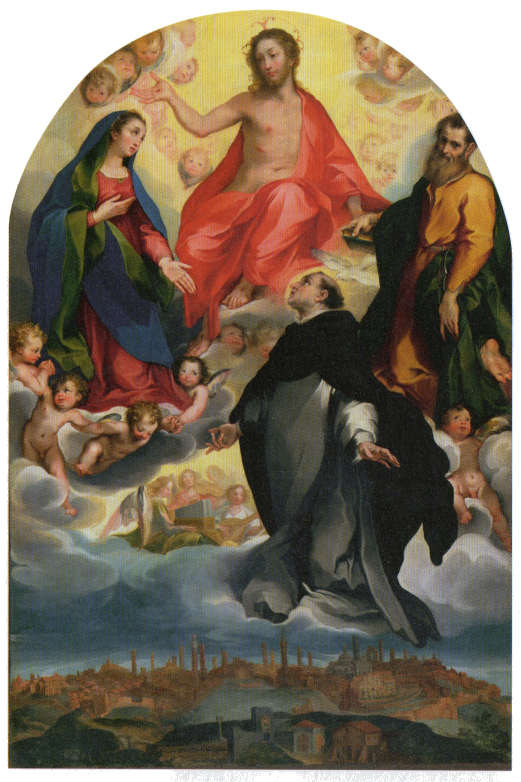
To the right of the altar is a painting of The Blessed Ambrogio Sansedoni Invoking the Protection of the Virgin for the City of Siena
(1590) (see left) by Francesco Vanni. The Blessed has somewhat
presumptuously been given a halo.
On the
middle of the right wall of the nave
is a Coronation of the Virgin
with Four Saints altarpiece by Bernardino Fungai (1508-1512).
A 16th century detached fresco
depicting The Visitation on the left of the
back wall is by Michelangelo Anselmi
The sacristy has a small museum dedicated to memorabilia, including a
whalebone said to have belonged to Christopher Columbus while he was, possibly, a student at the University of Siena.
Opening times
Daily 9.00 - 7.30
|
|
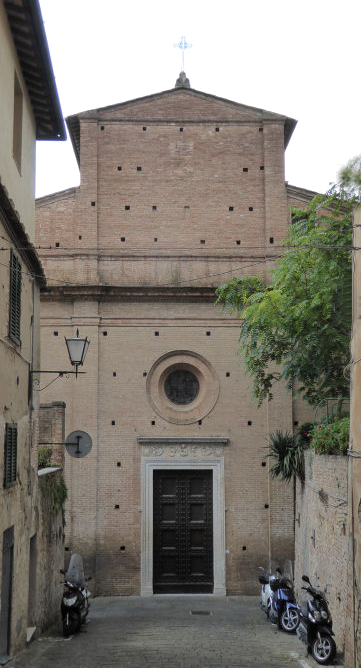
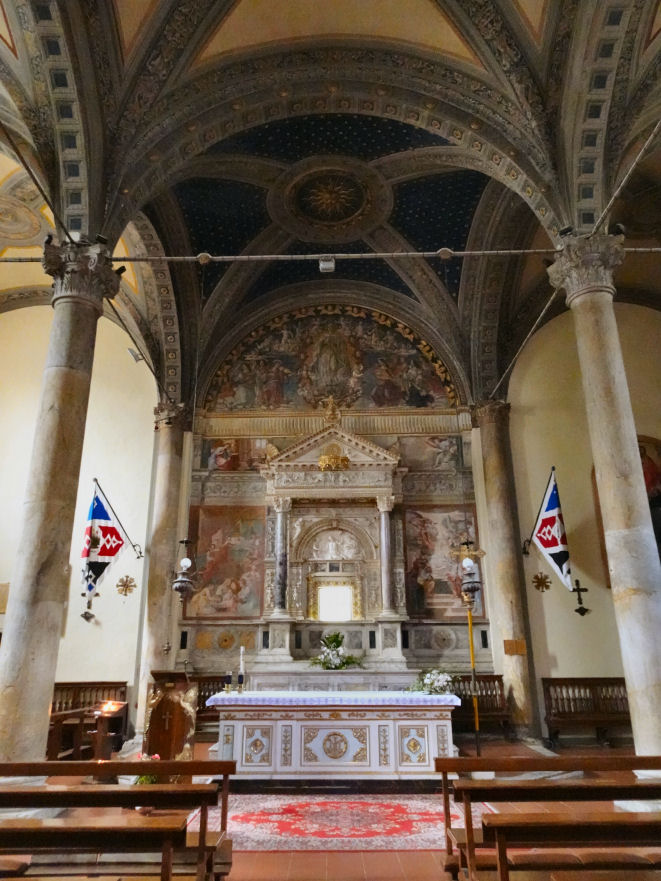
|
|
Santa Maria di Provenzano
Piazza Provenzano Salvani |
|
History
Built from 1602 and consecrated on the 16th of October 1611, with
the miraculous
terracotta
bust of the Virgin that it was built to house,
and after which the church is named (see
The Madonna of Provenzano
below) installed on the 23rd of October.
It's somewhat ironic that the church built to house this relic related to
the Sienese victory over the Florentines was one of the first major
building projects after the conquest of the city by Florence.
It has a rare-for-Siena ornate
baroque façade of 1604,
built to designs by Flaminio del Turco, said to have been based on
counter-reformation principles. The dome was designed by Don Giovanni de'
Medici, the illegitimate son of Grand Duke Cosimo I.
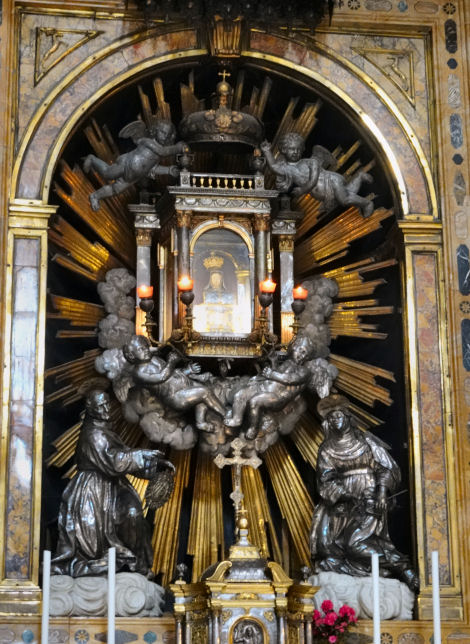
Interior
White-walled
with a short nave
and one buff marble altar each side.
17th and 18th century works by Bernardino Mei, Dionisio Montorselli,
Francesco Mori, Giuseppe Nicola Nasini, and Vincenzo Meucci. Also Rutilio Manetti
(first right altar) showing the Mass of San Cerbone (1630). Second on the
right is a canvas depicting Saints Catherine of Siena and Catherine of
Alexandria by Francesco Rustici
Very inlaid marble altars
at the
ends
of the transept
arms.
The
left
one has
a Crucifixion sculpture group and the
right a populated
Adoration
with an
inset
Annunciation.
The domed crossing has a marble-inlaid floor with the Medici family
insignia, they being the conquering Grand Dukes of Tuscany when the church
was being built.
The high altar on
which the
miraculous
15th century terracotta
Madonna del Provenzano (see right, explained below)
sits, is a flamboyant architectural work of 1617-32 by Flaminio del Turco.
In the crypt is the Oratory del Suffragio, the chapel of the Contrada
della Giraffa since 1824.
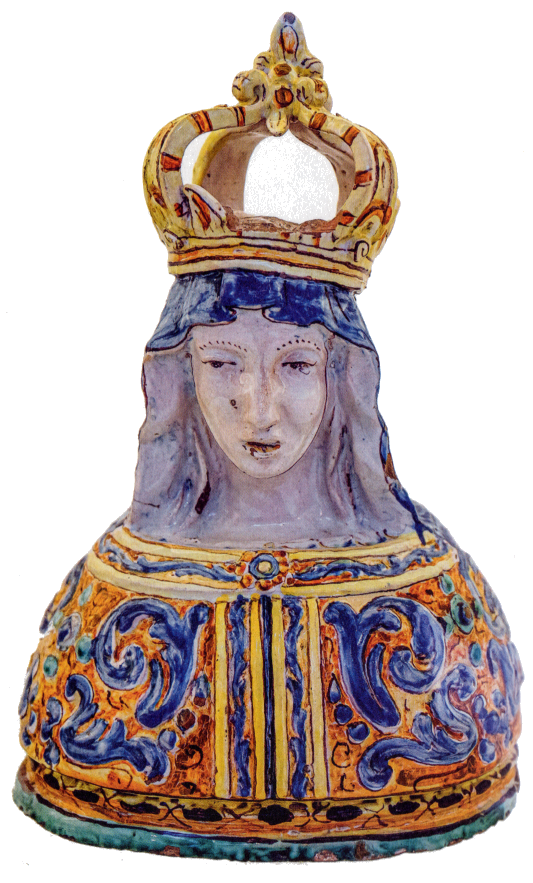
The Madonna of Provenzano
The bust's power is
said to derive from it having been on the facade of the home of Provenzano
Salviani, or at least a house nearby,
where it was allegedly placed by Saint Catherine. He
having
been the leader of the Sienese
army at its famous victory over Florence at the Battle of Montaperti in
1260. The miracle took place on the 2nd of July 1594 when the bust is said
to have cured a man with diseased limbs and/or 'defended itself from the
insults of a soldier'. Other reports say that the bust was
damaged by an
occupying Spanish soldier's
lance. He
then repented, or died
when his rifle backfired. The
faithful remain unperturbed by it having been found to date to two hundred
years after the battle. The Palio horse race held on
the 2nd of
July 2nd (the date of
the miracle) has been run in the
bust's honour since
the settling down of the number of palio
races to two in
1656.
Opening times
8.30 - 12.00 &
16.00 - 17.30.
Closed
Monday afternoon.
|
|
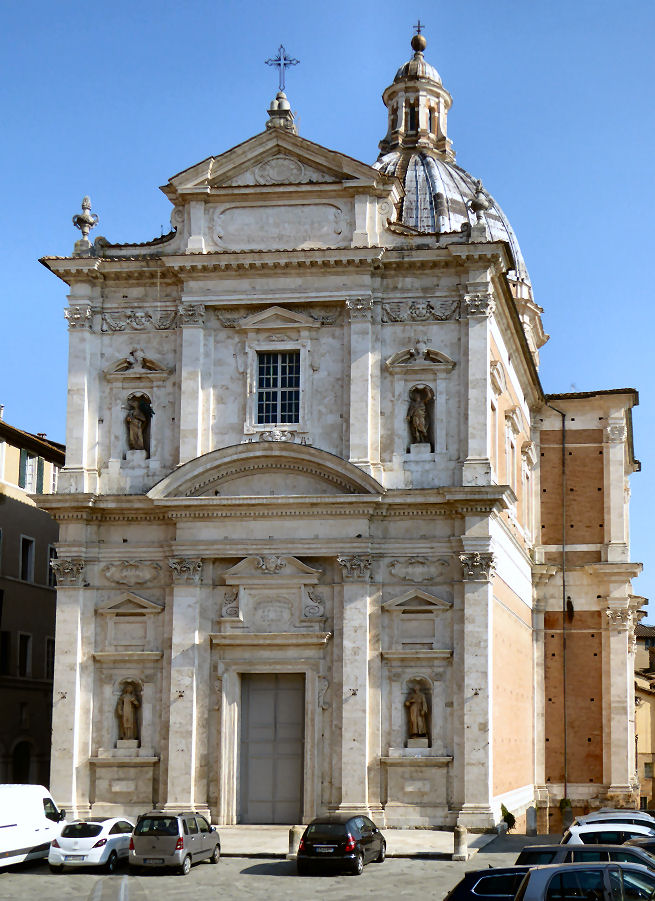
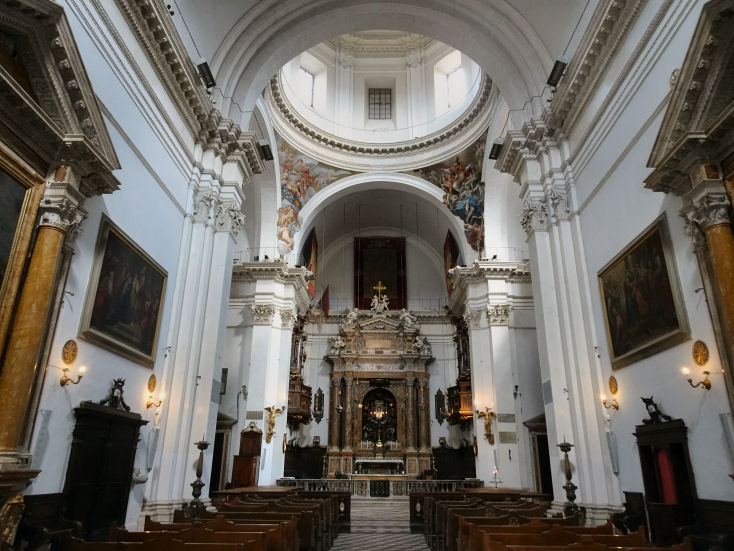
|
|
Santa Maria Maddalena
Via Pier Andrea Mattioli |
History
The monastery of Santa Maria Maddalena had been
founded in Siena, just outside the Porta Tufi, in 1339 by Margherita di
Benedetto. Later it came to be ruled by abbess Aurelia di Bartolomeo
Petrucci, the cousin of Pandolfo Petrucci, the Machiavellian ruler of
Siena in the early 16th century, who paid for a new church, designed by
Giacomo Cozzarelli, which was unfinished when the convent was demolished
in 1526. Petrucci's youngest daughter Portia and illegitimate daughter
Cassandra were educated here from c.1519.
So the displaced nuns moved to this complex in 1539 and rebuilt,
entrusting the work on the church to Antonio Maria Lari, called il Tozzo.
More rebuilding over the centuries with the interior completely redone
between 1715 and 1729 with late baroque stucco work.
The
neoclassical
façade was built in 1839 to a
design by the wonderfully-named Sienese architect Agostino Fantastici
(Fantastic Augustine) who also worked on Sant'Agostino, Santa Marta and
San Giuseppe, all nearby.
The church now houses the University of Siena and its Museum of Medical
Instrumentation (see below right).
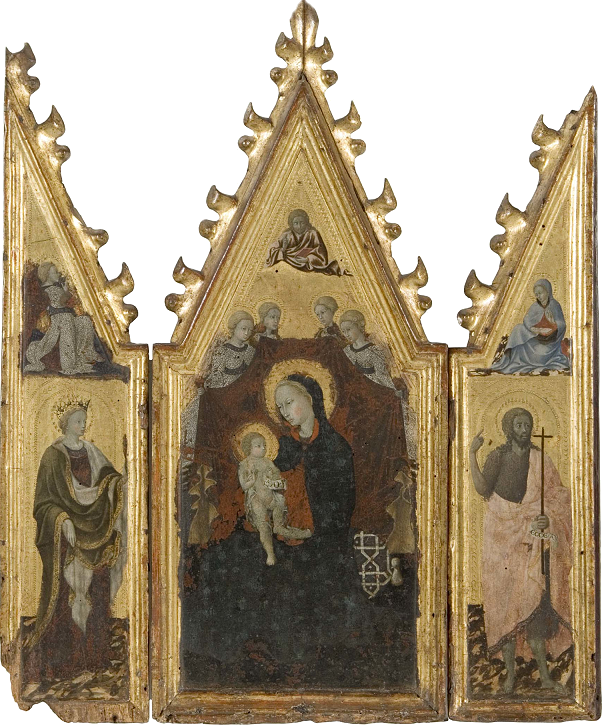
Interior unvisited
The high altarpiece is Saint Mary Magdalene listening to the preaching
of Christ of Raffaello Vanni. On side altars there are two paintings
by Antonio Bonfigli from 1729 depicting the Martyrdom of Saint Catherine
of Alexandria and the Virgin and Child with Saints.
Lost art
A damaged small triptych for private
devotion from c.1440, shows the Virgin and
Child and is by by the Master of the Osservanza (Sano
di Pietro?) (see right) and is in the Pinacoteca in storage. It
depicts the Virgin of Humility, between wings showing Saints
Catherine and John the Baptist with an Annunciation in the
spandrels above.
A wooden pulpit made in 1839 by Agostino Fantastici, is now in the church
of San Raimondo al Refugio, following the two church's merging in 1891.
Opening times Rarely |
|
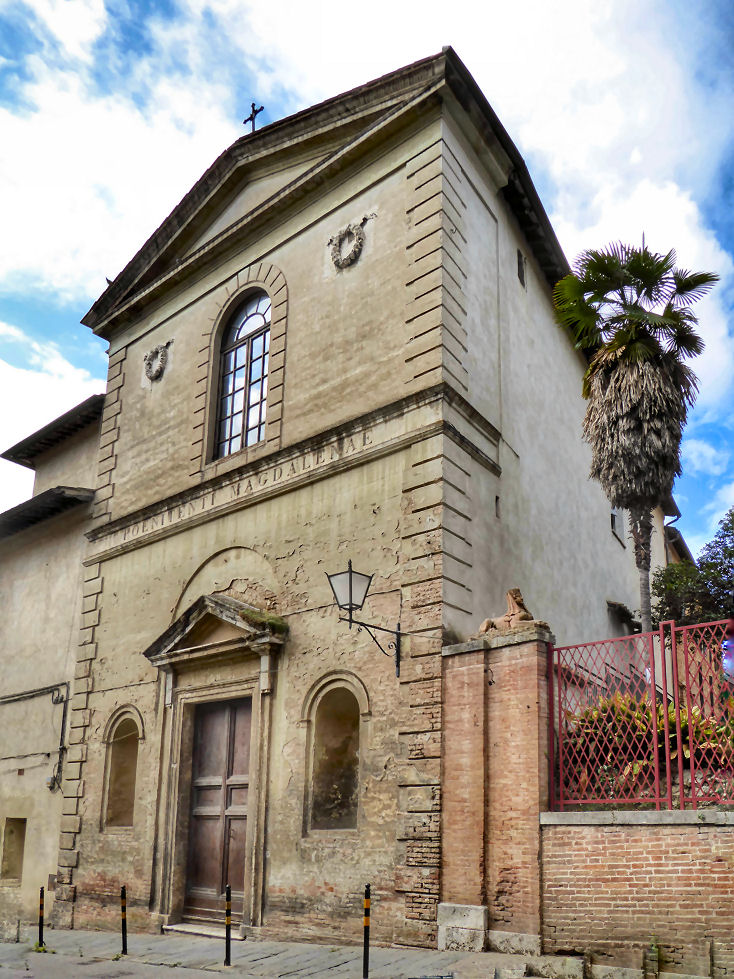
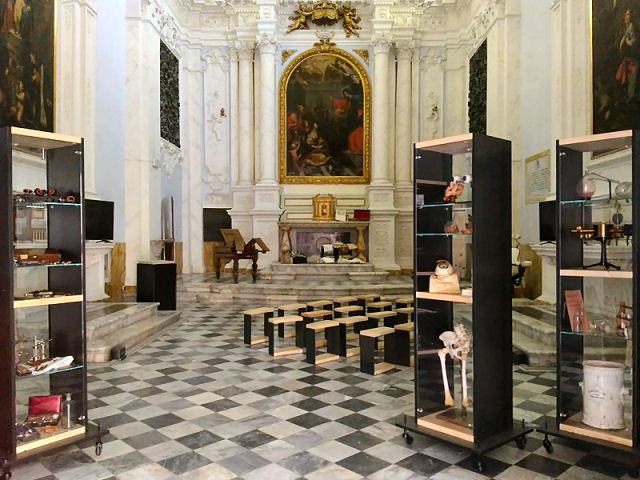
Photo above from Wikipedia by Antonio Giudilli
|
|
Santa Marta
Via San Marco |
|
History
The convent was founded in 1329 by Milla Pannocchieschi d'Elci a noblewoman who, when widowed, decided to build a
convent dedicated to Santa Marta following the rule of St. Augustine.
Initially for widows only, then virgins. Milla died in 1348 but her family
retained control of the convent. Suppressed in 1808 by Napoleon the
convent became a prison and then, briefly, housed the mentally ill before
they were transferred to the Asylum of Saint Nicholas. In 1814 the complex
became an orphanage and remained so until 1975 when it became a college.
It passed to the City of Siena in 1983 and in 1986 restoration work
began. Now houses the Istituto Storico della Resistenza Senese e
dell’Età Contemporanea archive and accommodation for rent.
Interior
unvisited
The original convent church now survives beyond
the east end of the later, late 16th-century church. 14th-century frescoes
remain on the right hand wall of the earlier church/ church choir. These
include the Burial of Saint
Martha by Matteo
Giovannetti.
There are also 14th/15th century monochrome fresco fragments in the cloister
(see below right) depicting the Life of Saint Jerome and the reclusive life generally.
The
refectory has a large fresco of 1522 of the Last Supper (found in
2004 under whitewash) by Giacomo Paccharotti, a colleague of
Pintoricchio.
Lost art
Two panels from a polyptych by Ambrogio Lorenzetti, depicting
Saints
Paul and John the Baptist, are in the Pinacoteca. As is a sweetly
impressive panel of Scenes from the New Testament (see
below) by Niccolò di Bonaccorso.
There are also panels of the Virgin and Child
with Saints, in the Pinacoteca and other collections, attributed to a
close associate of Simone Martini, which may be the remains of an
altarpiece made for the 14th-century Augustinian community here.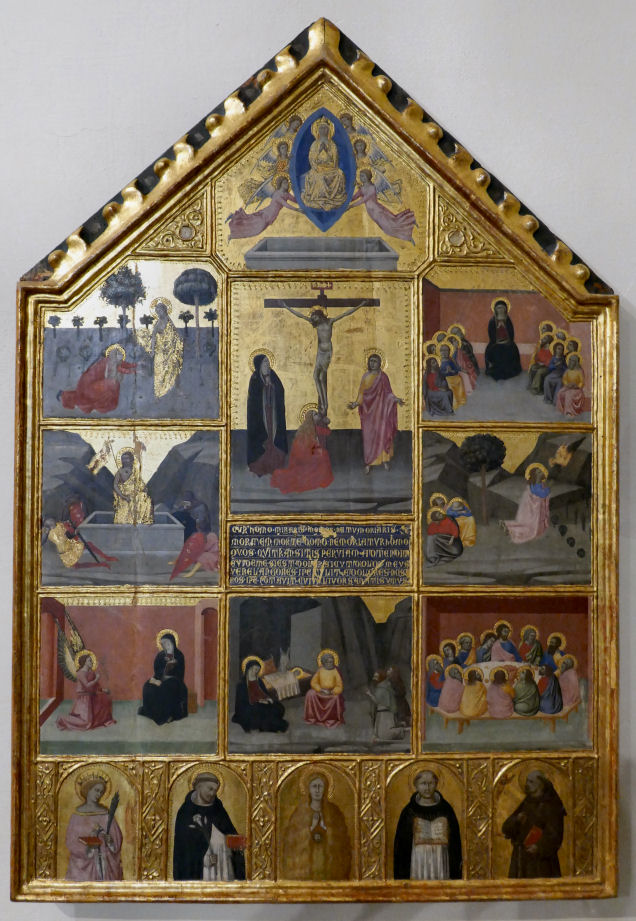
The Coronation of the Virgin with the Trinity, Saint Augustine and
Saint Martha by Francesco Vanni, now in the Palazzo Pubblico, was
probably painted for a side altar in this church
A cutting from an Antiphoner illustrated by the Master of the Osservanza
around 1430/40 which was probably made for this convent is in the Fitzwilliam Museum in Cambridge (It. 12). The cutting, showing Saint Augustine
sailing to Africa after his mother's burial, featured in the museum's
exhibition 'Colour - the art and science of illuminated manuscripts' and
the pigment analysis done at that time shows considerable differences from
the works by Sano di Pietro that are in the museum, thereby casting doubt
on his recent identification as the Master of of the Osservanza.
Opening times Rarely |
|
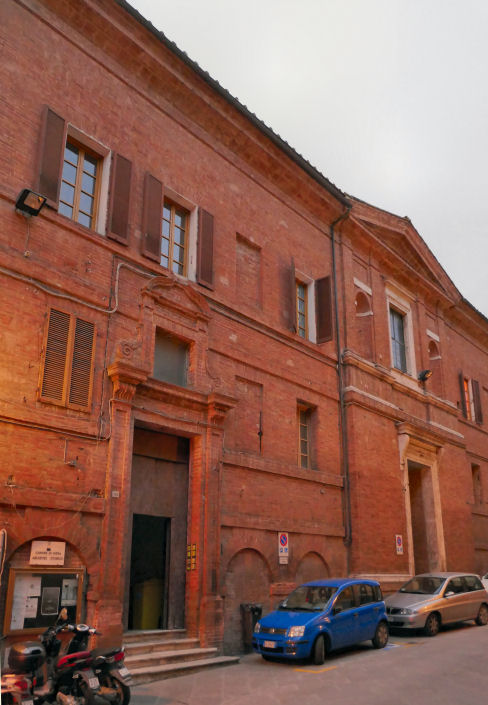 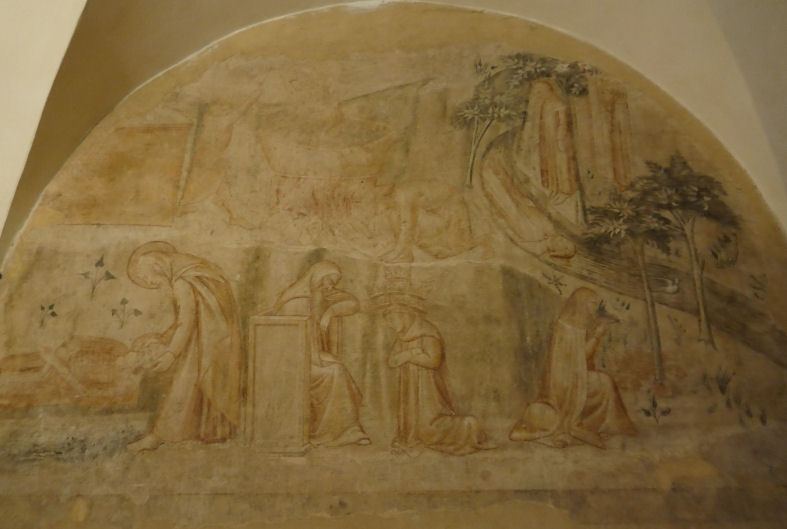 |
|
Santa Petronilla
Via Camillo Benzo Cavour |
 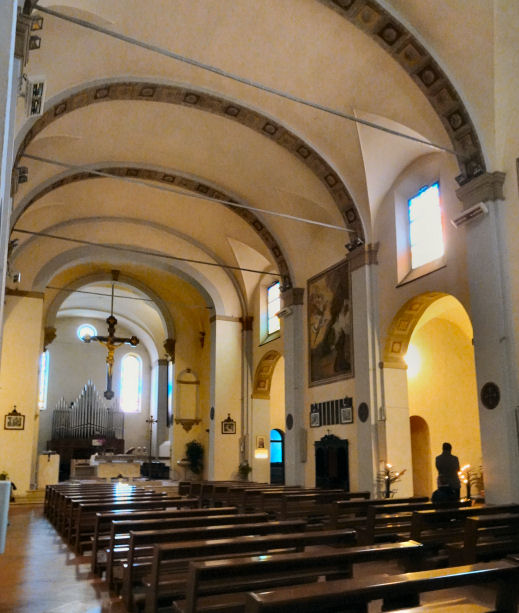
History
The original church, Clarissan convent and hospital had stood around here
since 1219,
but in 1553 the besieging
of the city by
the Habsburg Emperor Charles V and his
Florentine allies lead to the demolishing of the complex and the nuns
moving inside the walls. They moved
into the city to the Convent of the Umiliati. Their church, also called
Santa Petronilla, is dealt with in the Lost section below.
Construction of this church and
convent, outside the medieval walls and near the antiporta of Camollia,
was commissioned in 1622-1632 by the Capuchin Order. The convent and
church they built here was dedicated to the Santissima Concezione di Maria
(Holiest Conception of Mary). When the church of Santa Petronilla
mentioned above was demolished, the name was transferred to this church.
The Capuchin convent was suppressed by Napoleon in
1810. After this it was used as a cholora lazzeretto, a barracks, a
school, and an orphanage. It is now a home for the disabled, and the
church now belongs to the Archdiocese of Siena.
Interior
Wide and white-walled with a flat-curved ceiling. Three deep chapels either
side, mostly with monumental dark-wood frames, containing paintings or new
painted-plaster statues. Four large panels high on the walls between.
Stained glass at clerestory on the south side, and in the apse (standing
Virgin and Santa Petronila) is modern but not garish
17th/18th century art by Giuseppe Nicola Nasini and Apollonio Nasini (last left) Francesco
and Antonio Nasini and a framed altarpiece by Astolfo Petrazzi (middle left) A
Raffaello Vanni Death of Saint Joseph of 1629 in the frame in the first left
chapel was restored in
1997 but is still dark. The only painting in right-hand chapels is a Coronation of the
Virgin by Stefano Volpi on the wall in the first.
Two big panels by Mazzuoli and Guerrini either side of choir
Campanile
Neo-Romanesque, it remained incomplete for centuries, and was finally
completed after World War II. Some bells date from 1623 and another from
1790.
Opening times
8.00-12.00 & 4.30-7.00
|
Santa Teresa
Via San Quirico |
|
Santi Pietro e Paolo
Via San Marco |
|
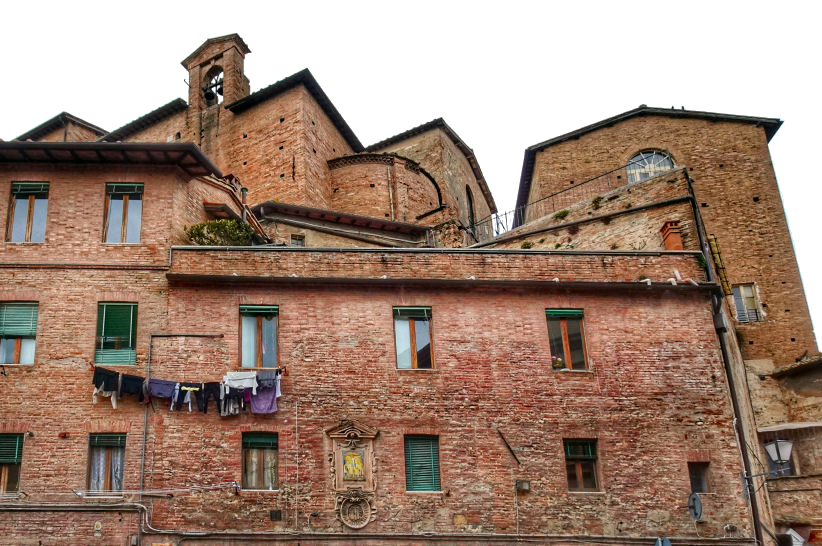
History
Oratory within the
former Institute of Santa Teresa complex commissioned by Monsignor Leopoldo
Bufalini as a school for girls. Built in Neo-Renaissance style 1877-1885 to designs by Giuseppe Partini.
Interior unvisited
The oratory has a wooden ceiling carved by Giorgio Badini. The high
altarpiece is the Transverberation of St Teresa of Ávila of 1875 by
Alessandro Franchi. The altar was sculpted by Leopoldo Maccaro. The
ceiling has Saint Simon Stock Receives the Carmelite Habit from the Virgin
also by Franchi (1884).
Other canvases include the Prophets Elias and Eliseo, St Girolamo Emiliani, and
a Santa Cecilia by Riccardo Meacci. Franchi also painted a Madonna del
Carmine with Saints Agnes and Louis; Gaetano Marinelli (1835-1924)
painted Saints Joseph, Bernardino, and Catherine; Giuseppe Catani painted a
Santa Caterina delle Ruote; and Leone Leoncini painted St Vincent of
Paul and St Thomas Aquinas and St Giuseppe Calasanzio.
Opening times Rarely
|
|
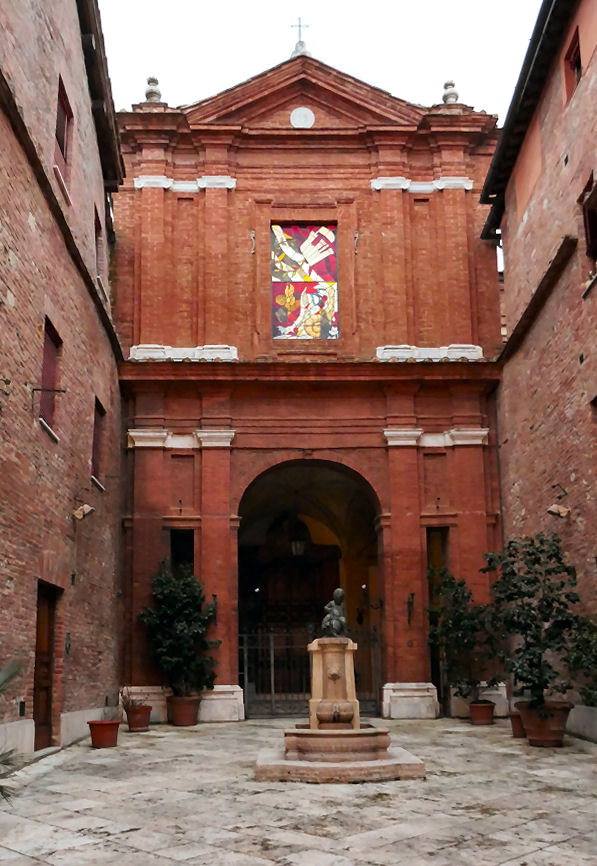
History
Originally a monastery which moved here in 1361, after the plague. This
original church, dedicated to San Paolo became too small and work on a new
church begun in 1622 to designs of Flaminio del Turco. The brick façade,
the work of Niccolò Franchini, was completed in 1678, The cupola,
supported with an octagonal tambor, was completed in 1645, with the
lantern reconstructed in Neoclassical style in 1818 by Agostino Fantastici
after an earthquake in 1798 destroyed the previous one. When the monastery
was suppressed by Napoleon the Contrada della Chiocciola moved here from
the Chapel of the Madonna del Rosario nearby, along with the art and
fittings from that oratory. The
church was then dedicated to Santi Pietro e Paolo.
Interior
unvisited
The interior has
stucco decoration (1711) by Giovanni Antonio Mazzuoli. The high altarpiece
is the Coronation of the Virgin with Saints (1520) by Andrea and
Raffaello del Brescianino. Another altarpiece depicts the Death of St
Paul by Astolfo Petrazzi. On the altar of the Rosary is a 15th-century
Virgin and Child. The crypt features a display of Palio victories.
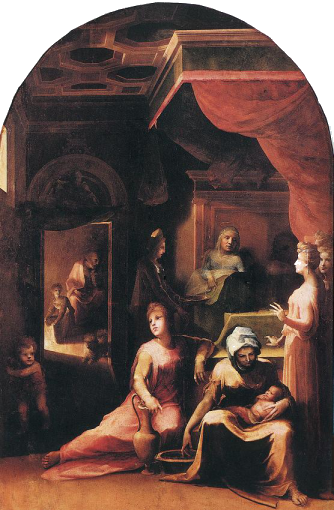
Lost art
The famous Beccafumi Birth of the Virgin,
from c.1530/40 (see left), from when this was the convent church of
San Paolo, is now in the Pinacoteca. The predella was detached, with three
panels (The Adoration, The Visitation and The Presentation) sold.
They later found their way into a private collection in Somerset.
Opening times Rarely
|
|
Santi Quirico (e Giulitta)
Via San Quirico |
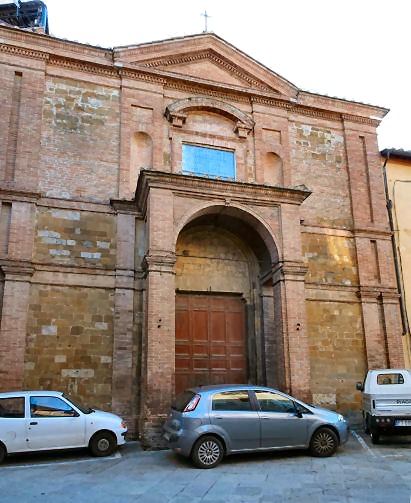 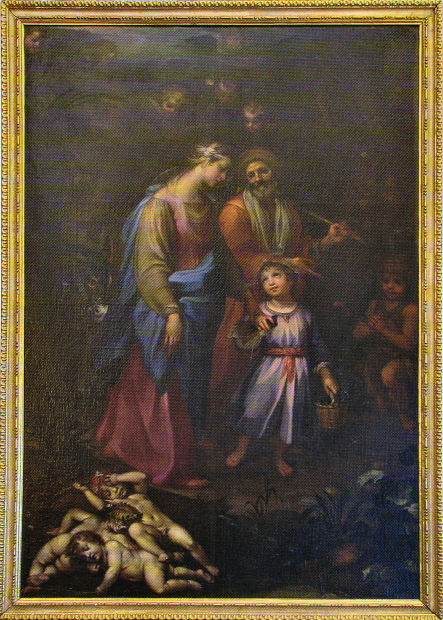
History
One of Siena's oldest, built on the
site of a pagan temple. Now dating to a late 16th/early 17th century
rebuilding but with 12th/13th-century remainders,
including some capitals inside and the fine Romanesque portal, over which
a lunette was frescoed by Ventura Salimbeni. The church is named after a
child-martyr and his also-martyred mother, in 304 in Tarsus.
The church served as the oratory of the Contrada della Pantera for a good
while, but they now use San Niccolò nearby.
Interior
unvisited
Paintings include several by Salimbeni, including The Martyrdom of
Saints Cyricus and Julitta, and works by Cristoforo Casolani,
Alessandro Casolani, and Pietro Sorri. The Sorri is The Disrobing of
Christ, a rare example of this subject used as the main panel of an
altarpiece. Also several by Francesco Vanni,
including a strange Return from Egypt from 1598, with the Holy
Family standing between the kneeling Infant Baptist and a neat pile of
massacred innocents (see right).
Opening times Rarely
|
|
Santi Vincenzo e Anastasio
Via Camollia |
|
|
|
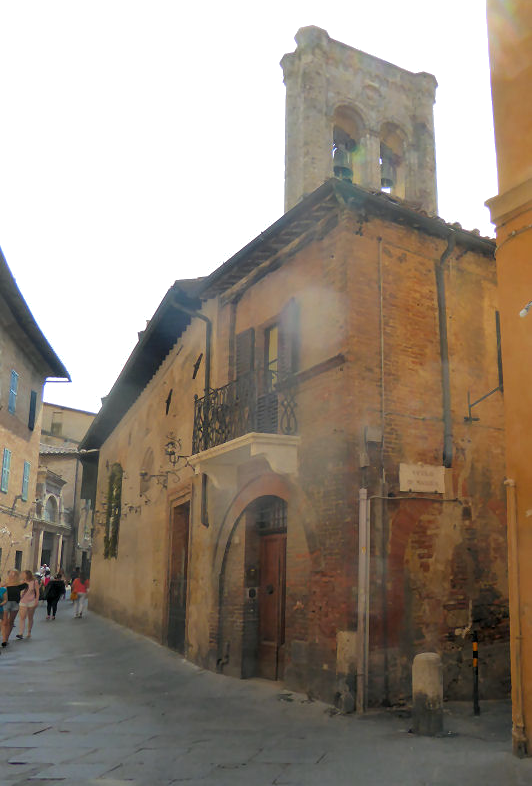
History
Said to date from 1144. Renovated in
the 18th century. Was the parish church until suppression in 1782 by Grand
Duke Leopold of Tuscany and in 1788 it transferred to the Istrice
(Porcupine)
contrada. The painter Pintoricchio was buried here in 1513 -
there's a small niche with a bronze bust on the right wall.
Interior
unvisited
Baroque interior with a
single nave and five bays. On left wall is a Virgin and Child with
Saints Bernardino and Jerome by Sano di Pietro.
Over the high altar is an 18th century wooden tabernacle with angels,
behind which are 18th-century monochrome frescoes by Carlo Amidei.
Contains much 18th-century art, but also an anonymous fresco of Christ
Pantocrator detached from the façade which is early-13th-century and
possibly the oldest painting in Siena. And is maybe no longer to be found
here.
Campanile
Neo-gothic, high and handsome, rebuilt in 1871 as the original
one had been damaged by an earthquake in 1869.
Opening times Rarely
|
|
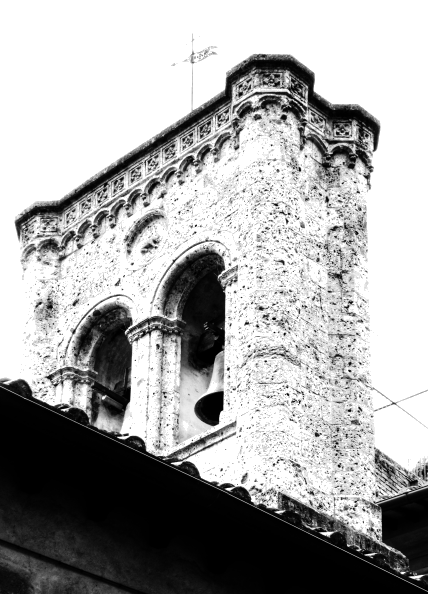 |
|
Santo Spirito
Piazza Santo Spirito |
History
Built from 1345 for
Benedictine Sylvestrine monks and then passing to fellow Benedictine
Vallombrosan monks in 1440, swiftly followed, from September 1498, by Observant
Dominicans who undertook major rebuilding from 1498 to 1530, financed by Pandolfo Petrucci,
to designs attributed to Francesco di Giorgio, resulting in the church we see today.
Petrucci became the ruthless ruler of Siena in the early 16th century and
overspent the city's money on many self-aggrandising projects. The
Dominicans were mostly non-Sienese, the majority from San Marco in
Florence. On Christmas Eve 1504 the controlling Petrucci expelled them for
refusing to breach an interdict, but he soon let them return, without
their prior. The convent to the right of the church façade was suppressed in
1848 and became a prison, which it remains. The church later became a parish church.
The brick façade has a Renaissance doorway attributed to Baldassarre
Peruzzi and dated 1519.
Interior
unvisited
An aisleless nave with four chapels on each side. The transept is
subtle while there is a deep choir with an apse. The dome with its
tall drum (1508) is attributed to Giacomo Cozzarelli (assistant to
Francesco di Giorgio) who also has many wooden and terracotta statues in
here attributed to him. Much post-rebuilding 16th-century art.
First chapel on right (the Spagnoli) entirely
frescoed by Sodama in 1520 (1530?), including a Saint Jacob
of Compostela Defeating the Moors, a very Spanish subject in a chapel commissioned by
Spaniards.
Also in this chapel, behind a grill, is a 1504
glazed terracotta
Nativity
by Ambrogio della Robbia, the Dominican nephew of the
more famous Luca.
The third chapel on the right formerly housed the Coronation of the
Virgin by Domenico Beccafumi mentioned in
Lost art below.
Further down on right, the transept chapel before the
high altar is the chapel of Claudio Bargagli, dedicated to the then-only-recently
canonised 13th-century Polish Dominican Saint Hyacinth (San Giacinto in
Italian) It has Saint Hyacinth in Glory in the vault by Francesco
Vanni, with his life depicted by Vanni's half-brother Ventura Salimbeni
on the walls, with Saint Hyacinth returning the sight of a boy on the left
and Saint Hyacinth walking on the water to the right. The altarpiece is
Saint Hyacinth Saving a Drowned Boy also by Francesco Vanni, of 1596.
The Borghesi altarpiece by Giacomo Pacchiarotti of 1505, although the
predella is in the Pinacoteca. A Coronation of the Virgin by
Girolamo del Pacchia from 1513/14 for the chapel of the Balisteri family.
(On the pillars either side of the high altar are Saints Domenic,
Catherine of Alexandria, Bernardino and Catherine of Siena by Rutilio
Manetti and in the apse The Pentecost by Giuseppe Nicola Nasini.
In the sacristy, part of the old cloister, is a 1516 fresco by Fra
Paolino da Pistoia.)
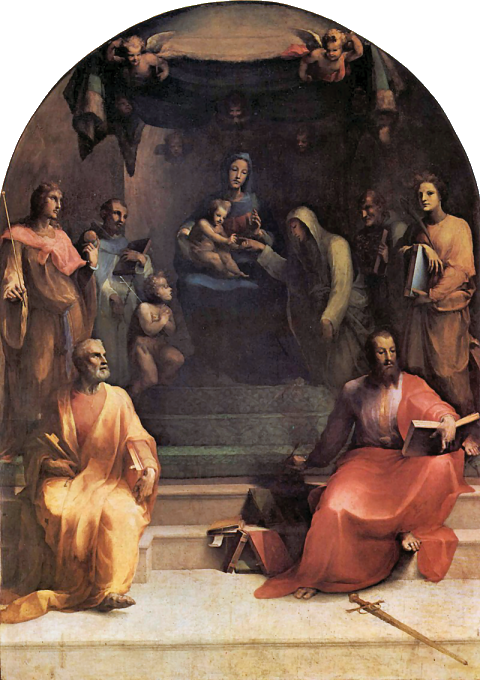
Lost art
A late 14th-century panel of the Virgin and Child Enthroned with a
Donor by Andrea Vanni, now
in the Diocesan Museum.
A very architectural Visitation from
1496 by Piero di Francesco degli Orioli (see far right) and Girolamo del Pacchia's
Annunciation with the Visitation of 1518 are both in the Pinacoteca.
The Mystic Marriage of Saint Catherine of
Siena by Domenico Beccafumi (see near right) that was painted for
the Gambassi family chapel c.1529, and admired by Vasari in 1538/39, is
now in the Chigi-Saracini. When it was acquired by Galgano Saraceni in the
early 19th century the predella panels were dispersed - two are now in the Philbrook Museum in Tulsa, and
one is in the Fitzwilliam in Cambridge. Later copies of the other two are
in the Museum of Fine Arts in Boston.
Another Beccafumi The Coronation of the Virgin of 1539 came here
from the from the high altar of the church of the convent of Ognissanti, outside the Porta Romana, when that church was destroyed.
It went to the Santa Maria Maddalena oratory in the early 17th
century, was taken to the Accademia in Florence in the early 19th century
when the oratory was closed, and came to Santo Spirito c. 1832.
It lost its predella and some stage and was
recently moved to the Pinacoteca
Opening times Rarely
|
|
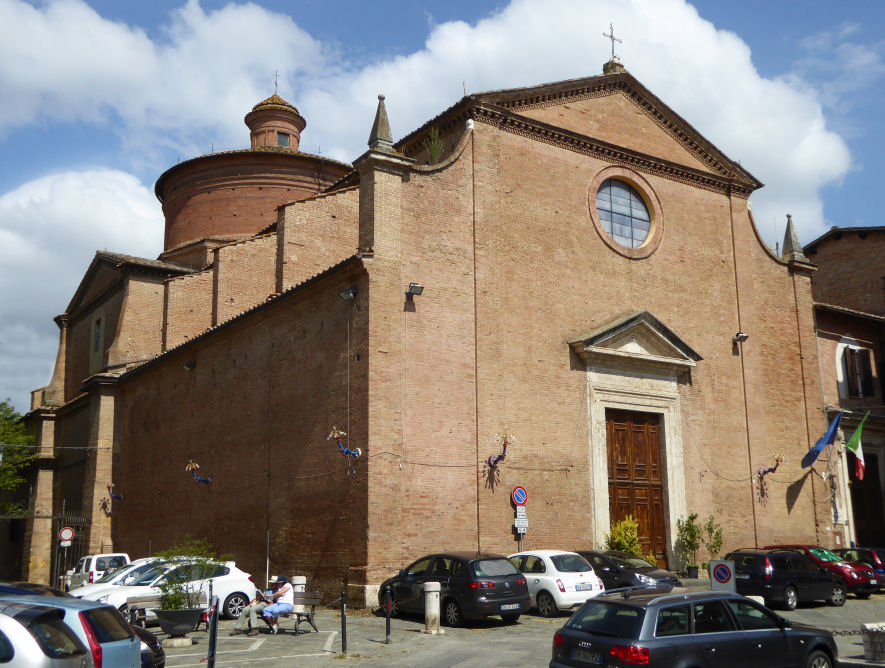
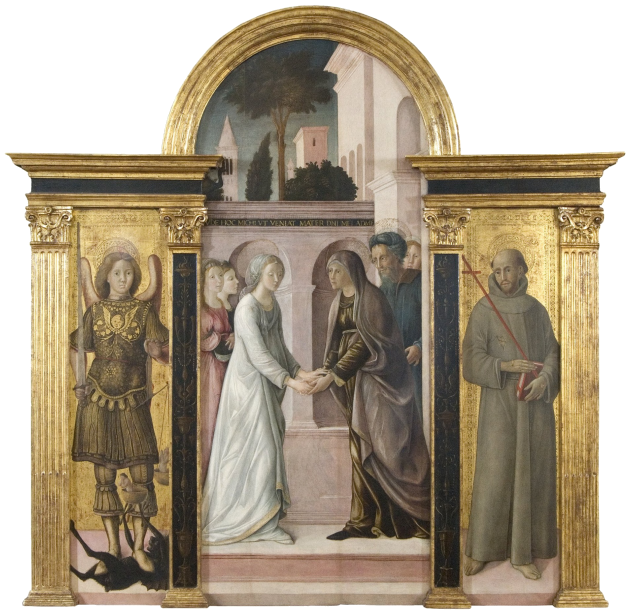 |
|
Santo Stefano alla Lizza
Via dei Gazzani |
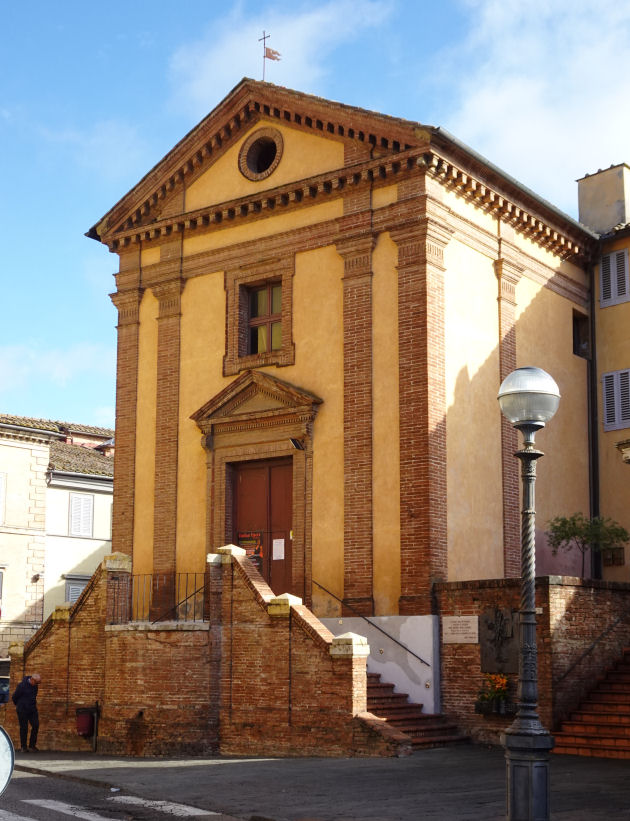 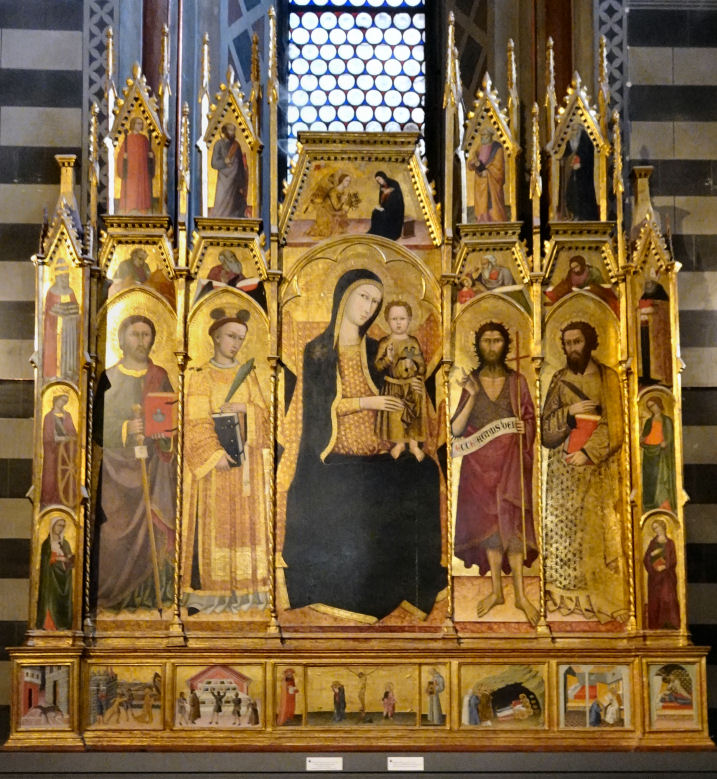
History
Founded in the 12th century and rebuilt baroquely in 1675. Formerly
falling into dereliction, the church is now used for opera performances.
Lost art
Housed the Virgin and Child with Saints (including Saint
Stephen looking even more like Mickey Mouse than usual) (1400) (see
left) by Andrea Vanni (with a predella by Giovanni di Paolo of six scenes from
The Life of St Stephen with a central Crucifixion with Saints Jerome and Bernard)
which is now in the Duomo Baptistery. As is a Visitation by Rutilio
Manetti formerly on the the right-hand altar here.
Opening times For concerts, and booking
them.
|
|
Santuccio
Santa Maria degli Angeli
Via Roma |
History
Founded by Augustinian nuns in 1362 and rebuilt in
1577 by Annibale Bichi,
this is the most substantial remaining part of the the adjacent convent of
Santa Maria degli Angeli.
The name Santuccio derives from the fact that the
major benefactors to the convent were members of the Santucci family.
Following
suppression at the end of the 18th century the church became a refuge for
nuns from other monasteries. At the beginning of the 20th century the
monastic buildings became a professional college.
The church and ex-convent buildings have occasionally recently hosted exhibitions.
Interior unvisited
The white and gilt interior houses an
altarpiece of the The Coronation of the Virgin with Saints Augustine,
Monica, Galgano, William of Aquitane and an Unidentified Saint begun by Francesco
Vanni (see right) in 1610, the year of his death, continued by Ventura Salimbeni, his
half-brother, who died in 1613, and completed by Sebastiano Folli in 1614.
Either side of the altar are a pair of panels
entitled The Concert of Angels signed by Ventura Salimbeni and
dated 1612.
The frescos on the side walls are also by Ventura Salimbeni, and depict
six episodes in The Life of Saint Galgano, a local saint whose head the
nuns long kept here in a silver reliquary, which is now in
the Museo dell'Opera del Duomo.
Opening times Rarely
But there were special openings in 2021, under the auspices of the
Pinacoteca.
|
|
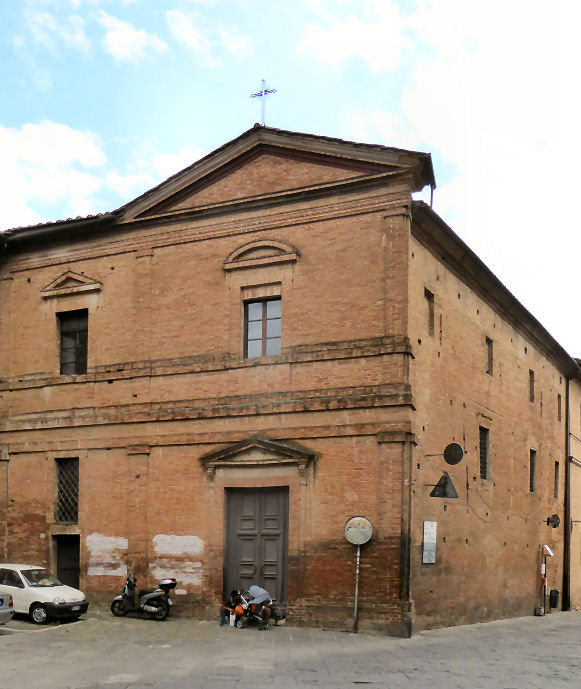 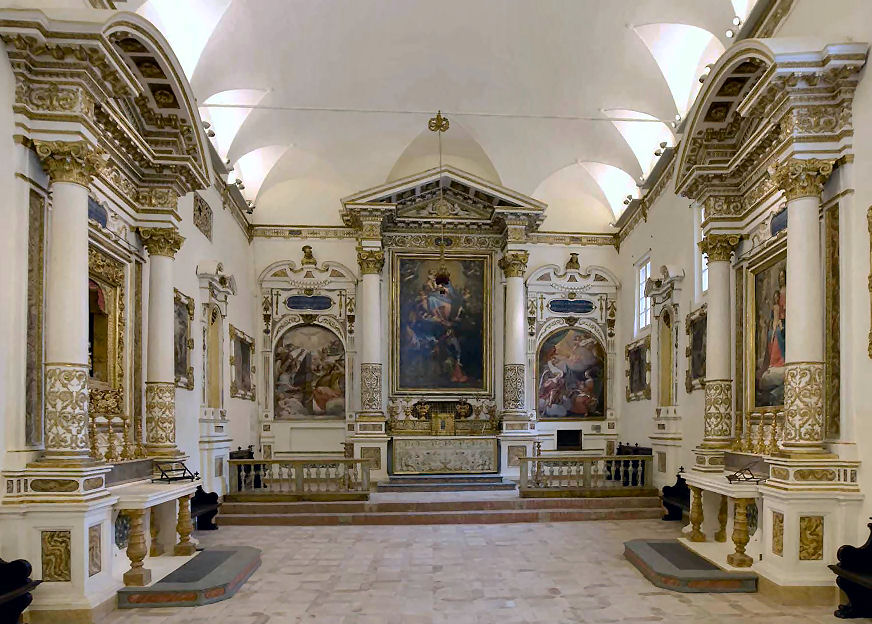 |
|
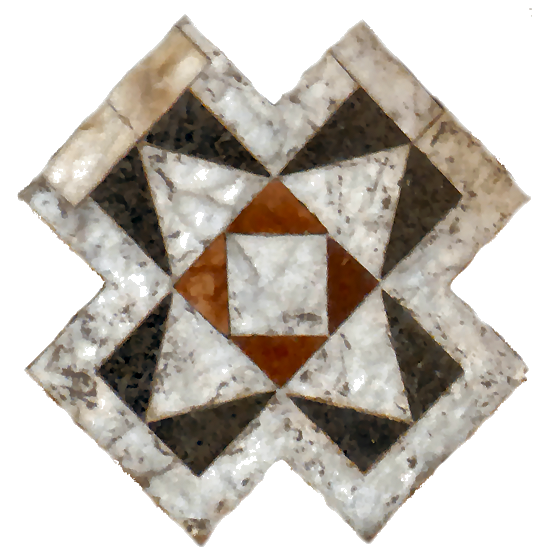
The Lost
|
|
San Benedetto
fuori Porta Tufi |
|
San Giusto |
History
An Olivetan monastery.
Lost art
An altarpiece of the
Stigmatization of Saint Catherine with Saints Benedict and Jerome 1515 by Beccafumi, now in the
Pinacoteca. Saint Benedict wears the white habit of the Camaldolensians,
an oddity explained by San Benedetto being an Olivetan
monastery. |
|
History
In 1181 Gunteramo, the bishop of Siena, authorized the building of a
chapel for the canons of San Martino. In the early 15th century the
canons of San Martino passed it to the Arte dei Battilana, who greased and
beat the wool before spinning, for use as an oratory.
Abandoned after the suppression of the guilds by Pietro Leopoldo, the Grand Duke of
Tuscany in 1777. Returned to use for a time, but by WWI it was in a state such
as to be used as a grain store. Demolished in 1936 with a chapel built two
years later to house remains. Commemorated in
the name of a piazza where it was sited.
Lost art
A superior Duccio-like Crucifix by an anonymous master is no.21 in the
Pinacoteca.
The San Giusto Polyptych by Pietro Lorenzetti is now no.50 in the
Pinacoteca.
|
|
San Maurizio
Samoreci
Via di Pantaneto |
|
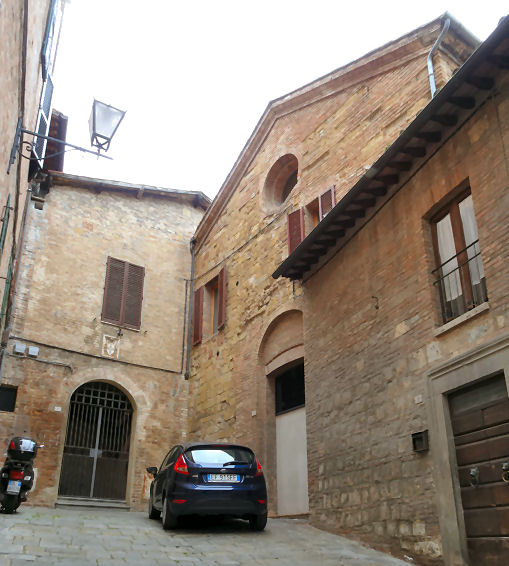 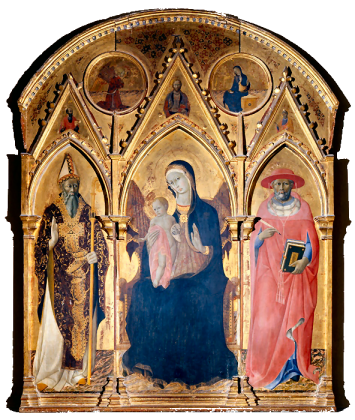
History
A church first documented in April 1064, with its name vulgarised
as Sant'Amorici, which later became Samoreci. A parish church through the Middle Ages, it was
deconsecrated in 1785, sold to a cooper and used as a warehouse. Only the
façade, with the pillared doorway and a rose window, remains as the side
of a house.
Lost art
The Mannelli chapel had an altarpiece painted by Paolo di Giovanni Fei in
1391, pieces of which, depicting Saint James Major, Saint John the
Baptist, and Saint Mauritius, are now in the Pinacoteca. Also
by him and in the Pinacoteca, a Birth of the Virgin of around the
same date, and clearly influenced by Pietro Lorenzetti's version of the
same scene now in the Duomo museum.
A high altarpiece from the mid-1340s by Niccolò di
Segna. The central panel, of the Virgin and Child, is in the I Tatti collection. The four main lateral panels are in Baltimore (Saint
Lucy), Atlanta (Saints Maurice and Catherine) and the
Pinacoteca (Saint Bartholomew). Smaller panels from the clerestory
level are widely dispersed, the pinnacles and predella panels are lost or
unidentified.
A Master of the Osservanza (Sano di Pietro?) triptych of the Virgin
and Child with Saints Ambrose and Jerome
(see right),
called the San Maurizio altarpiece,
dated 1436 and commissioned by merchant Manno di Orlando for his chapel
here, is now in the Osservanza, with its predella in the Pinacoteca (no.230).
|
|
Santa Chiara
Via Santa Chiara |
|
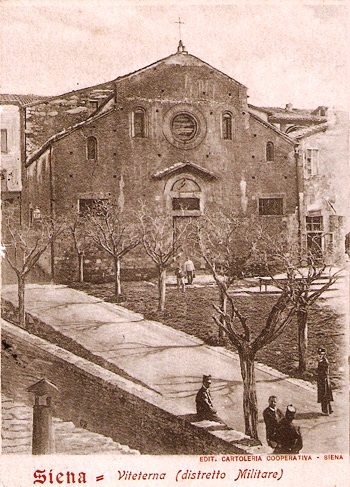
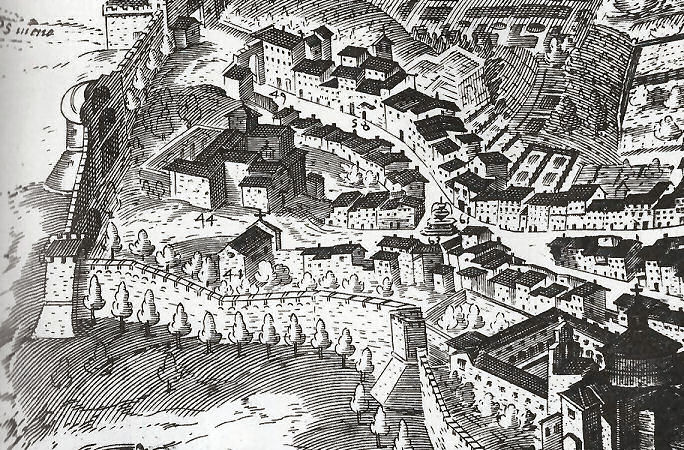 History History
The monastic complex founded here by the Vallombrosans at the end
of the 12th century, was already crumbling by1490. After the siege of 1555
Clarissan Franciscan nuns were forced to leave their then home outside the
Roman gate, occupied by the Spanish/Florentine troops, and on March 29,
1556 the abbot of San Giacomo and Filippo (as this complex was then
called) was instructed to leave the monastery so that
the nuns could move here. But the first stone of the rebuilding was not
laid until September
17th 1577 with the nuns finally moving in on 28 October 1596, with the
complex then taking the name of Santa Chiara. They remained until 22 July
1818 when the complex passed to Olivetan monks and was renamed the
Ospizio di San Benedetto in Santa Chiara .
The Olivetans left the ospizio on the 7th of July 1866, when the
monastery was suppressed. After a failed project to turn the complex into
prison, by 1872 it had been adapted to house a military barracks. Very
little remains, apart from the cloister, the church having been mined by
the retreating Germans on 2 July 1944 and almost completely destroyed;
but for two walls on which there's a plaque.
The Santa Chiara complex on Francesco
Vanni's map of 1595.
Lost art
An early-13th-century Sienese Crucifix (with a still very triumphant-looking
Christ) is in the Pinacoteca.
A late-13th-century Enthroned Christ with the Virgin by
Rinaldo da Siena, a recently-identified contemporary of Guido da Siena. He
was formerly, and sometimes still is, known as the Master of the Clarisse,
after this work. He is also said to be responsible for the frescoes
of the Crucifixion and Deposition in the recently discovered
'crypt' under the eastern entrance to
The Duomo.
The Breviarium fratrum minorum (Cod. X.IV.2) a manuscript in
the Siena Biblioteca Comunale of c.1430/40, has a calendar by Sano di
Pietro.
A postcard from the 1920s
|
|
San Paolo |
|
San Pietro in Banchi |
History
Attached to the Loggia della Mercanzia and
demolished in 1748
Lost art
A Saint Paul Enthroned by Beccafumi from
c.1515, now
in the Opera del Duomo museum. It was commissioned by the Corte degli
Uffiziali di Mercanzia. Flanking the saint are scenes of his
Conversion and his Decollation. |
|
Lost art
Saint Peter Enthroned with Six
New Testament Scenes by Guido da Siena (Guido di Graziano) from 1280
(see below) is now no.15 in the Pinacoteca.
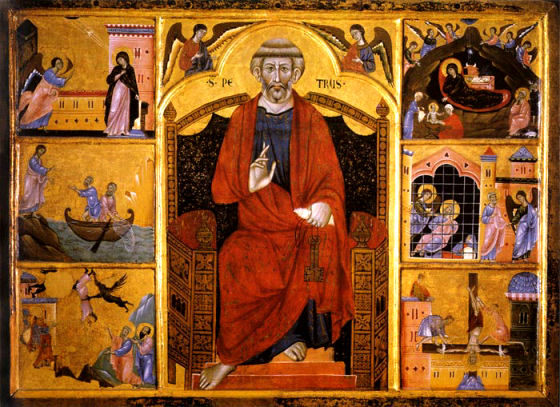
|
|
Sant'Egidio |
|
|
|
History
Capuchin convent founded by the Sienese mystic
Passitea Crogi. It was in what is now piazza Matteotti and was demolished to make way for a post office in 1903.
Giovanni di Paolo was buried here
in the chapel of Saint John the Baptist in 1482.
Lost art
The Visitation with Saints by Pietro
di Francesco Orioli in the Pinacoteca. |
|
|
|
Santa Petronilla
San Tommaso
Piazza
del Sale |
|
History
The church here was originally part of a Umiliati complex and called San
Tommaso, gaining this dedication in 1272 and passing to the order in 1293,
although the earliest documentary evidence for which dates to 1262. By
1344 it housed nineteen brothers and four conversi. Franciscans nuns who had founded, on a different site outside
the northern gate to Siena, the Porta Camollia,
a convent dedicated to Santa Petronilla in 1219, where forced to move out
in 1553 when the besieging of the city by
the Habsburg Emperor Charles V and his
Florentine allies lead to the demolishing of their complex and their
moving inside the walls. A church remained of this complex over which the
nuns retained patronage until they were suppressed in 1810.
The nuns eventually, in 1571, acquired
San Tommaso
and its convent buildings - the Umiliati having been suppressed in that
year -
and renamed it. It became known as Santa Petronilla degli Umiliati
until it
was suppressed by Napoleon in 1810. The church
and most of the convent fell into ruin was demolished in 1895, but the
remains of some of the convent buildings are said to remain on the south and west side
of Piazza del Sale converted into private residences.
Lost art
is in the Pinacoteca
A vivid and very Byzantine
panel of Saint John the Baptist Enthroned, with 12 scenes
from his life, by a 13th-century Sienese master.
A polyptych of the Virgin and Child with (half-length)
Saints Mary Magdalene and (her sister)
Martha (the latter formerly identified as Saint Dorothy) (c.1342-4) quite a late work by Ambrogio Lorenzetti
with arguable amounts of studio involvement (see right above). There's also a predella panel of The
Lamentation, (which oddly features not just Mary Magdalene but her
sister Martha and brother Lazarus) and two further side panels depicting Saints John the
Baptist and John the Evangelist. Scholarship has only slowly settled on
these panels being part of the same polyptych and the church they were
painted for, and the catalogue of the big Ambrogio Lorenzetti
exhibition in Siena in 2017/18 adds a couple of smaller half-length saints,
Massimino (as an Augustinian bishop - he also appears, unusually, in
the Lamentation in the predella) and Saint Anthony Abbot (see below).
That the names inscribed in the haloes in the predella match those tooled
into the haloes in the main panels makes a strong case for the panels
being from the same polyptych. There is little doubt now that this work
came from this church upon suppression, but it may have been originally
painted for another church, maybe in the lost Ospizio of Santa Marta.
The exhibition caption said 'From the now destroyed convent of Santa
Maria Maddalena outside the Porta Tufi gate in Siena?'
Also The Polyptych of the Assumption
by Sano di Pietro, dated 1479 (see right below). Below the Virgin
and her attendant musical angels are Saint John the Baptist, with a donor,
and Saint John the Evangelist. In the flanking panels are Saints Catherine
of Alexandria, Michael, Jerome and Petronilla.
The Polyptych of Saint Thomas,
signed and
dated 1362 by Luca di Tommè and Niccolò di Ser Sozzo, was probably originally
a high altarpiece. The lush Virgin and Child panel is flanked by
panels depicting Saints John the Baptist, Thomas, Benedict an Stephen.
Saint Thomas is at the Virgin's right hand, with a knife in his hand, an honour befitting the Humiliati church's name saint. The predella depicted
shaped scenes from his life
with a wide Crucifixion under the central Virgin. The latter is in the
Vatican and the four scenes are in the National Gallery in
Edinburgh, but were not on display in 2021, or even on their website. The pinnacle may have been an Assumption now in the Yale
University Art Gallery.
|
|
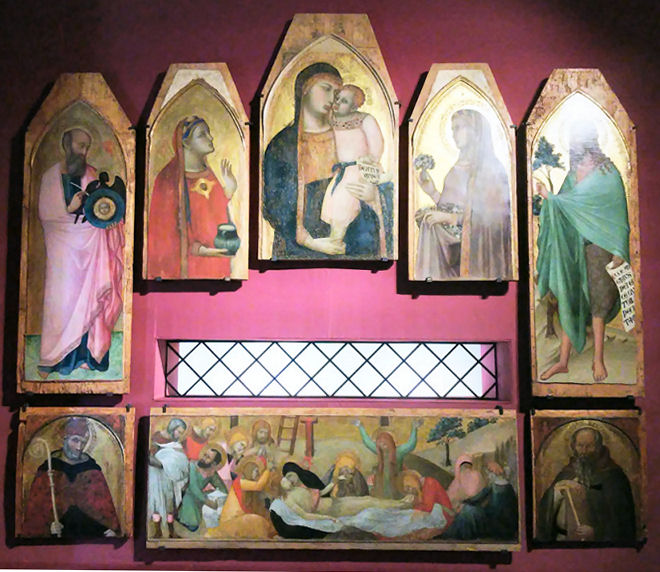 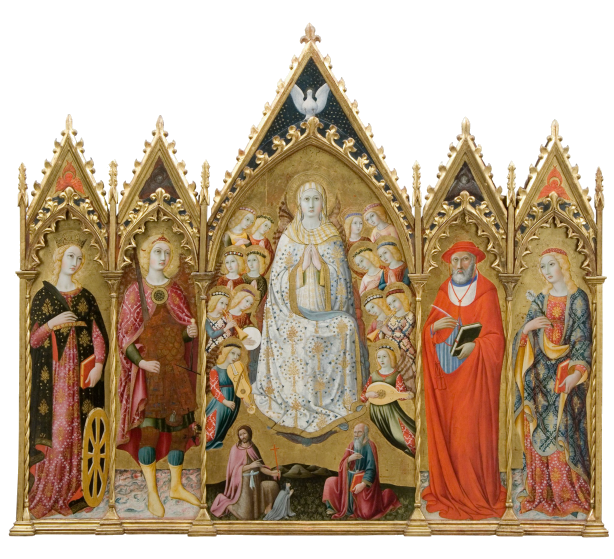
|
|

home
Centre
::
East ::
West ::
Oltrarno ::
Fiesole
Siena
† Pisa
|
|
|
|
|

























